#The animation was so very good!!! Especially on some detailed sequences during fight scenes.
Explore tagged Tumblr posts
Text
:)
#Mmmmmhh I like this episode :) More like I really really love Tachihara#He's something like. My third favourite b/sd character. No I never talk about him yes I still love him tons#The animation was so very good!!! Especially on some detailed sequences during fight scenes.#I don't really like the colours of the daylight scenes but eh nothing to tear one's hair over#I adoreee Yosano her character and backstory and personality are all so cool.#I love watching an episode so focused on her I wish there were more. I hope she will be okay#Kyouka and Atsushi spotted!! Always great to see them. Can't wait for the next episode I love it so much!!!#MITCHELLL I love her so much. Can she come back soon please#Overall a wonderful episode with all my favourite characters together eheh. Teruko! Jouno!#Gin's va is my least favourite casting choice of the whole franchise but it's probably just me ahah#random rambles
1 note
·
View note
Text
MVA In Memoriam (2/5)
The Comprehensive Account of the Butchering of My Villain Academia
(Introduction and Part One, Episode 108: My Villain Academia)
Part Two, Episode 109: Revival Party
Chapter 224 – Revival Party
• Mr. Compress’s side comment about how the distance Re-Destro wants them to travel means he must know they have warp capabilities. Also shortens his subsequent line, removing the bit about how their position has been locked onto, leaving only the marveling about the dude on the phone being the kind of person who has access to a satellite camera. Not a major cut, but it did strip out a bit of reiteration on how very Seen the League is. The warp line is another nod to how the MLA’s been doing their research—in particular, it ties in nicely with RD’s observations about the Noumu. He talks, there, about something Dabi said after the High End fight, which means he must also know that Dabi was warped out by an “Ujiko-san.”
• Also Mr. C’s observation that they haven’t broken Machia yet, and his posed question about what to do. Mr. Compress, I’m so sorry that you’re so wordy and lose so many quips and asides because the anime was set on brutally scything out every line of non-essential dialogue it could find.
• Ujiko’s extremely hilarious, “Listening to Villain Radio is my new favorite hobby,” line. Why would you cut this; this line is hysterical.
• The bit where Mr. Compress has the bright idea to use a High End Noumu like the one Dabi used, Ujiko rejects the suggestion out of hand, citing production woes, and Shigaraki says that he wasn’t going to ask for one of them anyway. Aside from being more cut Compress content (or “Comptent,” for short), it helps center the timeline somewhat at a point where the manga is jerking it around all over; it also shows that the League has been keeping up with news from the outside world. It also shows that at least one of them thought about using the Noumu—and since we know Re-Destro did some rationalizing on that scenario too, it’s good to see that it is at least briefly on the table. Further, Ujiko provides a few rare details about the Noumu creation process. Firstly, that AFO is normally involved, so his absence makes the procedure much more difficult (though not, apparently, impossible). Secondly, that Hood-chan was the only Noumu who’d actually reached the testing stage. This will be important later, for Ujiko’s agonizing about unleashing them early/Mirko having to fight four of them at once. Also, I just miss Mr. C’s funny little head wilt when Ujiko immediately turns down his “use some Noumu” idea. Ditto Shigaraki’s blasé shrug and little grin. Again, not to harp on the art too much, but man I wish the anime had kept all the fierce little grins and tight, incensed smirks Shigaraki has through the majority of this and the phone call sequence.
• Spinner’s line, “Without knowing squat about what we’re up against?!” A minor cut, as these things go, but it reiterates that there’s a chance RD is bluffing and the League has no way to know one way or the other, and demonstrates that the League can give Shigaraki some pushback on his decisions without having to worry about getting dusted for the temerity.[1]
• Takes one of Spinner’s lines—“Wait. I get it. Wherever you go, Shigaraki, he’ll sniff you out and hunt you down.”—and gives it to Shigaraki instead. Because fuck Spinner’s growing understanding of Shigaraki and the way his mind works, I guess! It’s especially notable that Spinner figures this out when Mr. C had completely the wrong idea about Shigaraki’s intentions—it demonstrates the way Spinner is gradually aligning himself with Shigaraki’s way of thinking, which we’ll see even more clearly during the War Arc. Also, again, it’s good to see the moments where the League weighs in on Shigaraki’s plans.
• The visual of Twice lashing out at Dabi with his razor-edged tape measure over Dabi’s dismissal of Giran, though all the relevant dialogue was there. Possibly this is because, having cut the CRC bit, the audience has no way of knowing that Twice’s tape measure is razor-edged, so why bother raising the question, “Why is Twice trying to attack Dabi with a tape measure..?” Possibly it’s because showing that attack would require animating movement, and MAN ALIVE, did Episode 109 ever want to do everything it could to avoid animating movement.
• Slidin’ Go’s line about how Deika isn’t usually his turf, but today is a big exception. This makes the hearty affirmative with which Trumpet announces himself a response to Shigaraki’s half-phrased observation about the reason behind the city’s emptiness, rather than a response to Slidin’ Go. It works, more or less, and probably even flows more clearly, all things considered. I’m always sad to lose lines from the vanishingly few named/characterized MLA members we have, though. I like, too, that it hints at the machinations that have to have been involved with setting things up for the Revival Party, and the way those plans were carried out with confidence that Re-Destro’s “bait the League into coming for their broker” plan would work despite the total absence of a response from the League in any of the time Giran was missing/his fingers were cropping up on the nightly news reports.
• A few shots of cameras in the city, which foreshadow Skeptic’s watchful eyes and ability to track the League through the city. In retrospect, this isn’t surprising, since the anime went on to cut basically any indication of Skeptic’s entire plan re: the footage of the League attacking, so why bother keeping the cameras? (Oh, right. Skeptic’s whole thing is cameras and information/disinformation. Skeptic for second-most screwed-by-the-anime MLA member.)
Additions
• Showed Toga having stood back up somewhere during Shigaraki’s explanation of their throw-Machia-against-the-MLA plan. A simply appalling choice. In the manga, she stays crouched down by Twice the entire time Shigaraki has his mask pulled off, because Toga cares about reassuring Jin-kun when he’s in a bad way.
• Rephrased Compress’s dialogue somewhat, also giving him a new line about the MLA’s forces in Deika when the League was still in the hills looking down at the city: “The so-called Meta Liberation Army has a force of 110,000 here.” I assume it was because the scene falls in a different episode than the tactical discussion did (in the manga, they’re the same chapter), so the anime was reminding the viewer of the stakes, but it’s potentially awkward because, er, no, the MLA categorically did not bring their entire army to Deika. We’ll find out as much for sure later, with the note that the regiment advisors weren’t in attendance because they were occupied at the bases they command, but even with only the knowledge we have here, Re-Destro’s statement about his numbers is that they’re scattered all over the country—hence the shot of Japan with a bunch of lights scattered across it to represent said numbers. That said, to be (briefly) charitable, there’s no particular reason for the League to assume that, and they did discuss the possibility that there were going to have to fight 110,000 people. So it makes sense that Mr. C might state as much when recapping for the audience.
Chapter 225 – Interview with a Vampire
• Re-Destro talking about Deika’s geography and why they chose it strategically. The anime dropped so much about the MLA’s planning and information-gathering beforehand; it really made the MLA look ludicrously overconfident. And while they don’t lack for that trait, certainly,[2] this is also an organization that has meticulously grown its membership for generations right under Hero Society’s collective nose; you don’t get to where they are by being unduly foolhardy. Erasing so many scenes demonstrating their caution and forward-planning undercuts the threat they represent to both the League and society at large. Also too, the descriptor of Deika as a nice, quiet, isolated little town in the mountains gives us some hints about how the MLA has avoided notice for so long, when you consider how the Hero business works: because so many people who get into heroism want to make it big, like celebrities, they don’t want to stick around small-town beats, and so the rural areas are understaffed.[3] That’s presumably why groups like the CRC and the MLA grow their numbers out in the boonies: much less attention from the Powers That Be. You can guess at some of that from how Spinner describes the place—“not too small, not too big”—and what Trumpet says about the percentage of the population that’s MLA, but RD adds that key “isolated” descriptor, and says that it’s a place where they “lay low.” That gives us some potential insight into how many—likely the majority—of the MLA came to their beliefs: by being raised to them, because their hometown was infiltrated by the MLA generations ago and they have literally never known anything else.
• RD’s phrasing, “Counter to point one,” when he makes his second point about the Noumu. He acknowledges that it’s counter-intuitive to his first argument, that he knows it would normally be an argument against that opening point, not in support. It’s just conversational padding, really, but “conversational padding” like that does a lot to distinguish character voice, so that not everyone talks the same way.
• A panel showing a trio of unnamed MLA warriors strategizing about how to divide their forces now that the League has split up. It’s the little cuts like this that gradually remove the agency of unnamed characters, such that they’re left looking like unthinking puppets instead of real people with the ability to register and respond to their circumstances. It also points towards the truth of what the MLA warriors are and one reason they’re so dangerous (for all that the manga itself will neglect this most egregiously later on): they’re trained in regiment tactics and accustomed to working in groups. This contrasts them both with villains, who might group together, but certainly don’t usually fight that way, and heroes, who are so unaccustomed to working in groups that it’s cited as part of the reason to have named super moves.
• Curious’s little pageboy-cut middle school kid line telling Toga to back off when Miss Curious is on the job. This is an early example of how defensive the MLA are of people above them in the hierarchy, an important thing Spinner will pick up on and attempt to use against Trumpet. Again, it’s little moments like this that both add some welcome notes of individuality to the MLA warriors (if only by virtue of Horikoshi and his assistants’ traditional talent for distinctive character design) while also fleshing out who the MLA are as a group, and contrasting them with the League.
• Deleted Toga’s line IDing her “on-the-go suck-suck mask,” but did insert a nice little bit of her expression shifting when she whipped it out. It lost a bit of the self-conscious silliness of her support item name in exchange for a cool little animation beat. I don’t dislike it, particularly, but I am, as previously stated, very leery of edits that make the League more polished in their villainy at the cost of their human foibles.
• Curious’s line about having come prepared to counter Toga’s moves, which was supposed to further reiterate that the MLA has done their research on the League; they didn’t just decide out of the blue to target the most notorious Villains in the country without studying up on them first and planning accordingly!
• Curious’s line about how she’s going to get started with some background info while her people use their meta-abilities to keep Toga and her buddies on the ropes. A marvelously characterful line! It speaks especially to that edge of formality the MLA brass observe that even as she’s ringleading this attack, Miss Curious is still set on going through her interview process step by established step.
Framing Shifts
• Made some of Curious’s lines spoken dialogue instead of internal monologue. That’s probably fine for when she’s waxing enthusiastic about Toga’s lack of hesitation in committing murder or how she’ll use Toga’s story to further the MLA’s agenda. It’s less fine when she’s rattling out the entire name, brand and patent status of her support item for no particular reason when Toga is already halfway through trying to knife her (that’ll be next chapter).
• The anime implied pretty firmly that Curious’s bombers died. And like, yeah, that’s always made more sense than the idea that anyone could survive something like that, but I hate it anyway. For one thing, it makes it even harder to credit the idea that Toga’s still on her feet afterward if Curious’s supposedly not-very-lethal explosions merk all her own people. People in this series survive ludicrous amounts of damage, and these random MLA devotees are no exception! For another, it leans into the narrative that the MLA higher-ups throw away the lives of their minions without the slightest care. It’s a lot harder to make that case when it’s explicit in the manga that Curious’s people survive the blood explosions—the blonde in the tracksuit is unharmed enough to snicker about it, and the noodle chef is even doing well enough to continue attacking! I’ve always been of the opinion that the MLA are, yes, willing to spend the lives of their underlings on attaining goals, if that’s what they think is necessary, but that is not at all the same as gleefully throwing them onto the pyre to watch them burn.
Additions
• Some individual shots of Mr. Compress, Dabi and Twice fending off or fleeing from various MLA types. A nice try on getting the group split up, but it feels kind of budget save-y, when we could have gotten actual animation of those fights instead.
• Inserted a quick shot of a headline about Toga’s first attack as Curious was rambling on about why she’s interested in Toga but not the League in general. Actually a fairly reasonable insertion, given how much text is crammed into her talk bubble in the manga while the dude standing next to her is already getting a knife in the neck.
Chapter 226 – Bloody Love
• A panel of interviewees talking about Toga’s first victim being sociable and popular. It gives a bit of context on what he was like, what people thought of him, but given that we know enough about Toga at this point to know that his popularity was entirely incidental to what she liked about him, it’s not a huge loss.
• The detail of the broadcasted interviews censoring Toga’s name. Considering how Japanese media normally treats minors accused of crimes, this is an eyebrow-raising change—the manga censors it because Japanese media outlets would have done the same. No idea why the anime didn’t, unless it’s another of those places where it would feel too “real,” to have something that so closely mirrors real life treatment of criminals?
• Everything about quirk counseling, and whoo boy, that is a loaded cut. There is exactly one other mention of quirk counseling anywhere in the manga, and, curiously enough, it also comes up in relation to a villain: in the U.A. faculty meeting after the USJ attack, Midnight muses that maybe Shigaraki never received quirk counseling in elementary school. It’s a weird little non sequitur there—exactly what sort of program did she expect could single-handedly make the difference between a well-adjusted adult and a gleefully murderous manchild with aims on killing Japan’s Number 1 Hero? Just over two hundred chapters later, we get a hint: a program designed to fit people “neatly into society’s little boxes.” Quirk counseling, then, is not about helping children find healthy ways to process their quirks, but rather, about teaching children what is and is not acceptable in terms of quirk use—and as Curious says, Toga’s admiration of blood was never going to be acceptable.[4] This explanation doesn’t just tell us a lot about Toga—that she wasn’t only failed by the hysterical condemnation of her parents, but also by a society that had no interest in helping her if it didn’t see a use for her—but also provides some insight on the viewpoint of the Meta Liberation Army vis-à-vis mandatory state-funded programs that dictate what “normalcy” looks like to impressionable children. Curious is, of course, not a particularly trustworthy narrator in this, as one might expect of someone who uses language like “society’s little boxes,” but it does track with Midnight’s earlier musing of, “Maybe the anti-social dude never took the program intended to make sure he was a functioning member of society.” That kind of statement—“State-sponsored educational programs are there to program children into becoming unthinking cogs of society, actually.”—is one that it’s all too easy to imagine the people with an eye on broadcast standards taking issue with, even coming as it does from the mouth of a villain.
• Curious’s line, “Let’s turn your death into a legendary tragedy, shall we?” and its accompanying visual of two different papers with imagined headlines. The dialogue doesn’t strike me as crucial—Curious’s fervent belief in Toga’s story is amply demonstrated elsewhere and her intent to turn that story into a legend reiterated in the line immediately following—but it is a shame to lose the headlines. They tell us, in Curious’s own words, exactly the tack she was planning to take in telling Toga’s story to the general public, without the constant namedropping of the Liberation Army that she does when talking about it in person. One headline in particular—The Price of Suppression: A String of Bloody Murders—is an especially useful reference for discussing whether the MLA actually wants, as is popularly claimed, completely unhindered quirk use, even for people like e.g. Muscular who want nothing more than to murder people with their quirks.[5]
• Curious’s initial wait what response to getting Floated, and her people’s focus shifting away from Toga and onto Curious instead. On a surface level, that focus shift helps explain why Toga’s able to zip around the ground and touch nearly twenty people before they even react: because they’re afraid for Curious. It also hurts the ongoing characterization of the MLA rank and file as being fanatically devoted to their higher-ups which, again, is something Spinner is supposed to notice later. It’s the worst kind of plot device if that devotion is completely told to us rather than consistently shown!
• Toga’s internal reflection that she’s seen Ochaco use her quirk, and knows how to use it. It’s obvious from the panel that she knows how to use it, but the manga implies that Toga transforming doesn’t automatically grant her an understanding of peoples’ quirks; it’s only in observation (and possibly love) that she can reach this particular unlock. Leaving out that information leaves open the possibility that she can just do this all the time now, with anybody she transforms into.
• The reaction from the surviving crowd to Curious’s death. See above re: STOP FUCKING ERASING HOW MUCH THE MLA CARES FOR EACH OTHER.
Framing Shifts
• When Toga bolts, Curious in the anime sounded serious, her expression alarmed, like she was actually worried that Toga might escape, even though her dialogue said just the opposite. Maybe you could say that she was afraid Toga would die before she got her statement, but given that she tried to kill the girl herself moments later, I’m skeptical of that claim. Regardless, in the manga, she never loses her smile, and she flashes a Liberation salute as she stands up to give chase. It’s a characterization note, that she’s so wildly confident about this that she never stops being completely enthralled with whatever Toga has to show her.
Chapter 227 – Sleepy
• The last of Toga’s conscious dialogue, about how she’s lost a lot of blood, is fading out, can’t move—but more notably, the way that this state of things makes her feel closer to “them,” that it’s “the same sensation.” And who is “they” here—her victims? The people she loves? More alarmingly, why does the line sound like she’s been this beat-up before, and remembers the sensation? Does that tie into e.g. her comment during the training camp that she doesn’t want to fight too many hero students at once because she doesn’t want to die? Has she actually been subject to this kind of violence before in the past? Does that tie into her still-unexplained ability to erase her presence? It’s an interestingly loaded little line, for being so vague, and illustrative of Toga’s mentality on becoming the people she loves. Which also lets the scene segue nicely into Re-Destro’s observation that, in Toga Himiko’s world, there’s no such thing as “other people.” On which note, guess what else the anime cut?
• The entire fucking scene where Re-Destro actually reacts to Curious’ death, the motherfuckers. This lost: 1. RD’s talk about the way Toga sees the world and how that led to society casting her out, which he points to as evidence of said society clinging to old ideals even though the nature of humanity itself has changed. It calls back to his methodology with Detnerat, marrying his lines from the commercial to his overarching ideals; it also shows that he understood very well what Curious saw in Toga, and demonstrates that he can express that understanding and empathy even in the face of losing one of his closest allies. 2. Skeptic’s reaction to Curious’s death, which is pretty sparse, but at least present. He says she never should have been on the front lines—an excellent reminder to the people who’re always going on about how the MLA brass thinks themselves so above their followers: Curious was on the front lines, against the wishes of some of her peers!—and calls her a valuable resource.[6] You can theorize about Skeptic not caring for her beyond her usefulness to the cause, or just that Skeptic is a huge autist who processes his emotions differently than most, and isn’t going to stop to do that when there’s still a battle going on, but either way, you need this scene to do it accurately. 3. Speaking of people who process their emotions in unusual ways, as I said above, this scene also shows Re-Destro openly crying over the deaths of Curious and each and every warrior diving into battle with their hopes for the future. They’re not crocodile tears, either. As was the case with Miyashita, there’s no one in this room that Re-Destro would need to perform grief for: Skeptic clearly doesn’t see a use for tears right now, so I don’t see him expecting them from Re-Destro, and the only other person in the room is Giran, a hostage who the MLA—very probably Re-Destro himself—maimed! It’s not like RD’s tears are going to change Giran’s mind about him (indeed, Giran gets a comedic reaction beat at the absurdity of the dude who started all this up here crying about it)! But RD says life is precious and he cries anyway, briefly, before he ruthlessly turns it off. RD’s valuing of human life—especially his own peoples’ lives—crops up in roundabout ways twice more, both leading the fight with Shigaraki (“It angers me.”) and ending it (“Any more would bring about meaningless death.”). This, though, is when he’s most open about it, to the degree that—as with Machia’s grief—it’s kind of off-putting and strange. Cutting it makes it that much easier for people to get entirely the wrong impression of RD as a character. 4. The delightful scene where Skeptic berates Giran about asking brainless questions and then answers his question anyway. Fuckin’ hell, why cut this?? So much of Skeptic’s character is in this scene! You get moments of his neuroticism later on, but never in so concentrated a burst as this (there’s one other sequence that could compete, but—spoilers—the anime cut that one, too). The exchange also explains the cameras placed throughout the city—which are visually referenced early on—and what the MLA is planning to do with their footage. Without that explanation, the audience has no idea how, exactly, the MLA was planning to use wiping out the League as a springboard for their grand return to the spotlight. That footage is the crucial part of how the rest of the country reacts to Deika in the Endeavor Agency Arc, and the anime never even mentioned it! The audience was just left to assume that all the media came in afterward, not that there was the slightest whiff of footage from the battle itself. 5. Once again brings up Re-Destro’s belief in the power of the heart to move other hearts. We get a bit of that in Curious’s flashback, but here he says it in his own words—as he will also bring it up to Shigaraki. Once again, Shigaraki is going to be challenged about his conviction, which ties back into what Spinner and Ujiko demanded from him earlier in the arc. With so
many people set to be grilling Shigaraki on this front, it tells us again what the arc is for: Shigaraki’s conviction, and him demonstrating it to the people who think he lacks it.
• The panel of Spinner asking how long they’ve been at it and Mr. Compress responding. This line helps manage the pacing, giving the audience an idea how much time is passing as we cut around to different places. It’s also, you know, more cut Spinner dialogue, and shows the beginnings of Shigaraki and Spinner getting split off from the rest by Shigaraki’s sleep-drunk staggering angling him off in a different direction. The rest of the scene is moved to after Toga’s fight with Curious, but not otherwise tampered with.
• The other big reaction to Curious’s death, which is Trumpet using it to rile up the crowd. The group that attacks Shigaraki isn’t just some free-roaming mob—they’re coming at him in a grief-stricken frenzy, which they’ve been goaded into by one of their leaders. This sequence also introduces the campaign van—a vehicle that will have several more appearances—to events, and hints at Trumpet’s meta-ability. Further, it’s one of the scenes that outright states that the MLA is less an army than a religion, in Mr. Compress’s line about how Trumpet is like a preacher rallying his flock. That understanding—that the MLA may style themselves as an army, but what they really are is a cult—is key to the way the MLA members act, from the very bottom to the very top.
• Trimmed Shigaraki’s flashback down, cutting—among other things—the very first lines Hana speaks, and her namedrop. This moment is the first one Tomura gets back, and the very first thing we find out is that he was doing something he wasn’t supposed to be doing. The anime also failed to identify Shimura Nana’s relation to Tenko/Tomura and Hana—helpful to remind the audience of a plot thread they haven’t heard about since Kamino. It also cut out the silhouette of chubby baby Tenko and Tenko’s first line, asking why Hana’s showing him this, a line which clues us in that Hana was the impetus here, not Shigaraki as he was back then. Still not satisfied, it also cut the phrase, “Daddy said all that stuff,” which is a clear and ominous warning that there was some conflict going on between young Shigaraki and the Father whose dismembered hand he now wears on his face.
• Left the dialogue but cut the silhouette of an airborne Geten with his enormous ice fists coming in hot behind Dabi when he was smarming about it not being his style to take the pacifist route. It’s not crucial, since we see the fists again shortly (it’s the end of the chapter page, whereas the anime rolls right on into the continuation of the scene), but it’s a shame, since framing Dabi from below with this sudden presence behind him is a much more fun, dynamic angle than the dead-boring medium shot the anime used. Also too, it’s good foreshadowing for the fact that Geten can fly, since he certainly didn’t get that kind of air by jumping off the roof of the mini-mart across the street.
Framing Shifts
• The crowd attacking Tomura came at him from the back of the shot, whereas in the manga, they’re surging forth from the front; that is, the anime had Shigaraki between the crowd and the POV of the viewer, whereas the manga has the crowd interposing between the viewer and Shigaraki. It makes a huge difference in the impact! Running up from a nebulous background distance, the crowd looked small and futile. Crossing directly in front of the viewer as they attack Shigaraki makes them look like the crashing human wave that they are. But, you know, coming in from the front would mean they’d have to be animated with more detail, and again, Episode 109, more than any other episode in the arc, clearly didn’t have the budget to spare on such things.
• The moment Shigaraki first uses the spreading Decay is horrifically clear in the manga. It’s full of speed lines, Shigaraki moving so fast he decays a dude mid-word, but the impact itself is spread over two pages. We watch his hand literally cleaving through the leading attacker’s face, and then are encouraged to linger on the oversized panel below, the intricately drawn crowd, full of individual faces, still intact on the left, scattering to dust on the right, all fully lit, with Shigaraki—still drawn with speedlines to emphasize his movement—the focal figure in black at the center. The anime rendered this moment in two stills—Shigaraki’s hand about to hit the lead attacker’s face, and then the crowd already decaying. There was virtually no movement to it, the crowd was so heavily silhouetted against a glare of daylight that it was difficult to tell what was going on, and the moment stayed on screen for only two seconds before Shigaraki landed and threw up, both actions favored with more animation than one of the signature moments of the entire arc. Hell, it even left the walls on either side of the alley intact, when the manga shows them dissolving into ash as well, decay traveling through the ground in a deadly, destructive radius around Shigaraki’s attack. The anime ever-so-graciously allowed Spinner his line to explain to the audience what just happened, but I think that’s mostly because it would be genuinely difficult to parse if he didn’t. It also gave him a flashback to what we had literally just seen, except this time it wasn’t silhouetted for some reason, so at least the audience got another chance to look at it, I guess? “Am I seeing things? Just now, his decay effect spread to people he wasn’t even touching!” Well, I guess we’ll have to take your word for it, Spinner.
Additions
• A quick shot of a camera, there and gone almost too fast to register. I want to compliment the anime for adding a camera back in, since it removed the shot of the cameras earlier, but honestly, given that it cut all the scenes about how and why the MLA was gathering footage, I really don’t know why it even bothered. Also too, the camera was gone so fast it felt more like a marker for a scene change—which it also was, segueing the scene from Toga collapsing (only to cut back to her later staggering down an alley) to Spinner and the rest still trying to hold their own—than it did something the audience was supposed to really notice.
Chapter 228 – Wounded Soul
• Twice in the opening pages left out scattered members of the MLA that were around for the start of the Dabi/Geten fight. Leaving them out raises the question of where all the people attacking went, but it’s also the first demonstration that Geten is a danger to his own allies. We don’t see any of them dying on-panel or anything, but we do see them having to dive frantically out of the way because Geten demonstrates no care to the collateral damage of his attacks.
• Cut a small flashback, presumably from Twice’s perspective, of finding the site where Toga and Curious’s fight concluded. You can see the ground covered in blood, and a body that looks a bit like Curious if you squint (distinguishable by the sleeves of her jacket), as well as a small group of people kneeling on the ground in various poses suggesting mourning and a paying of respects. Yet another shot demonstrating the depths of care these people have for their leaders, that they’ve completely let the battle fall by the wayside in favor of their grief.
• Drops the “those zealots” phrase from Twice’s, “I’ll rip those zealots limb from limb for this!” line. Damn, the anime really was determined to erase everything that even hints at the Liberation Army being something much creepier and more damaging than just an underground militia, huh?
Framing Shifts
• For all my complaints about the material, I generally like the voice acting quite a bit. I don’t love the first exchange between Dabi and Geten, though. It’s not a fault of the voice actors themselves, but rather the delivery. Geten was very cool and level-headed throughout, which is all right to a point, but he’s a gremlin under that troll parka, and this fight is where we hear him as close as we ever will to how he is before the multi-layered humbling he’s subject to over the course of this fight. It’s a bit of a shame to play him totally straight, without any of the snark he’s so clearly capable of—and without the tick upwards in vehemence his talk bubbles indicate in his last lines. Meanwhile, it’s fine for Dabi to get more heated as the scene goes along, and indeed he does, but he also plays it pretty cool at first. You can tell in the shape of his talk bubbles that he’s completely unruffled during his delivery of that, “Consider this a freebie, just for you: ice melts,” line. The anime had him raising his voice for it, and it just loses a lot of the humor of Dabi’s own snark to have him yelling it instead of just laughingly stating it, voice barely raising enough to give his talk bubbles some straighter lines instead of being all undisturbed curves. (For comparison’s sake, it’s about the same level of angular as Geten’s, “You’d best not think your little campfire can melt my ice!” line, but the anime had Dabi shout his line, while Geten continued at the same unperturbed volume he’d maintained since the beginning.)
• As with Shigaraki’s first mass decay, the shot of Geten’s ice dragon did not make the impact on me in the anime that the manga did. I think it’s mostly the way the ice was colored? The claw’s pretty good, but the head looks blobby and indistinct, more like blue soft-serve than the shifting, sharp-edged, brilliantly bright sculpture-in-motion of the manga.
• Twice’s voice actor did his best to sell the scene of him finding Toga, but I wish they’d kept that tight close-up on his mouth when he says, “Give it up. The girl’s dead.” They animated him leaning closer to the camera, but that doesn’t have the sharpness of that sudden cut to being right there on his lips, like some malevolent thing is using them to speak words so terrible that they can’t even be associated with the rest of his face.
---
Come back next time (and hopefully in less time) for Part Three, Episode 110: Sad Man's Parade.
FOOTNOTES
[1] We would, of course, have an even clearer idea of that had the anime not cut the scene of Spinner shouting in Shigaraki’s face.
[2] It seems particularly strange to me that Curious and RD both mention quirk evolution as a thing they know can happen in extreme circumstances, but didn’t predict that backing the League into a life-or-death corner might provoke one or two members to undergo exactly that evolution.
[3] Mount Lady is the obvious example, but you can look to places like the island in Heroes Rising, too: one hero, and when they retired, a group of high school kids had to go sub in for a while until a replacement could be arranged. It’s not like retirements just happen overnight; the Commission had to have known it was coming. Still, they had to scramble to find someone. It doesn’t suggest they had anybody just champing at the bit to take the post, you know?
[4] In Chapter 140, we see a young Tamaki Amajiki in a class called “quirk training.” It’s uncertain how connected this P.E.-like class is to quirk counseling, but Toga wouldn’t have been getting much help there, either, seeing as it’s all about figuring out how to use one’s quirk in a way that’s “useful to society.” I can think of some ways, but nothing that I expect would be very popular or liable to be explained to a grade schooler in a country with as long a history with ritual cleanliness as Japan. To a Shinto mindset, Transformation isn’t just off-putting or unhygienic; it’s spiritually unclean.
[5] The answer there being, no, obviously not, or Curious wouldn’t, in all apparent sincerity, be trying to characterize Toga using her quirk to murder people as an undesirable outcome, a cost society is paying for its current stance on quirk use. Yes, you can gather that much from her calling Toga a tragic girl, and Re-Destro concurring later, but listen, I will take every line I can get that I can use to push back against the wretchedly widespread idea that the kid whose name means Apocrypha is the be-all-end-all source on MLA ideology, somehow more reliable and trustworthy than every other MLA character combined, including Destro himself. I would very much like it if the anime had not deleted a bunch of my talking points while making good and sure to leave all Geten’s most damning lines intact.
[6] Not that an anime-only person would fully understand why some random reporter was all that valuable a resource, since the anime cut the explanation of what Curious actually does for a living.
#my villain academia#bnha#bnha meta#boku no hero academia#my hero academia#my writing#stillness has salt
39 notes
·
View notes
Text
I have a lot of mixed feelings about how Sakura is generally perceived by the Naruto fandom. I haven't been here for very long, but it's an understatement to say that man, they hate her. I guess apart from Sakura stans or SS stans (who I am not even going to give much space here because their reading comprehension of content is below par and almost unbelievably projectional), when almost every other subcategory of this fandom, even the dudebro kind, just like, abhors Sakura, like the stuff is pure vitriol.
But I am trying to be thoroughly objective here.
Throughout part 1, I can honestly say she appeared to be a character who was self absorbed, spoilt, skin deep and childish. But the thing is, she Was a child. At that point, I knew that I had long way to go towards the end of the show, so I knew being one of the supposed main characters, she would go through an arc, and possibly grow up. I couldn't begrudge her coming of age.
During the initial part of Shippuden, I could see that Sakura had grown up in some way. She definitely had matured to some extent. She had a better grasp of her emotions over losing Sasuke than Naruto at this point. She even comforts Naruto and defends him against Sai, and I kinda liked that moment despite myself ( I for one never liked Sakura but was willing to give her a chance at redemption at this point, well that and anyone defending Naruto gets a little bit on my good side). She was training hard. Even if it was unoriginal, she was kinda doing her own thing. I thought, hmm that isn't so bad. She makes a few bad choices, but she is also adjusting to new and improved Naruto in team seven, new responsibilities. Yes, she is not the best fighter but c'mon man, she was literally put in a team with two of the mightiest ninjas of all time, and it wasn't her decision. She was liable to feel insecure. Cut her some slack. Compared to team seven, all the other teams anyway look like benchwarmers.
It's mostly what happens after Sasuke is condemned as a terrorist that made me lose all hope for her. One bad decision after the other in this arc (and all the other arcs after this one). This convinced me Kishi had had enough of this half hearted development at this point, he just went like fuck it, it's time for fucking War, let's get fucking on it! This is where his SNS was going to shine after the long hiatus and overflowing anticipation of Naruto and Sasuke teaming up together (I mean just look at the ridiculous build up of their upcoming team up at the war, Kishi brought out all the big guns, the former hokages for Sasuke's entry, hahaha awesome. Then Sasuke and Naruto's own fights, especially the final one, just look at what the animation people did, the fucking detail, the atmos, the sound design, lord damn). Because let's be honest, it's battle manga.
After that, at such an advanced stage of the series, Kishimoto just like...spat on her 'legacy' over and over again in the war arc. Like it was almost painful. After Everything, when Sasuke slams his hand in her torso and puts her in his horrible genjutsu, just because she would have tried to stop him from getting hurt, I was like my God Kishi stop already! You have made your point! She may not be perceptive, but that was way too harsh. In terms of commensurate action- reaction, that was just way too much for a reasonable Sasuke to do, who btw had already had a pretty good time (all things considered) at the war fighting big bad villains alongside his 'best buddy' and had kinda temporarily come out of his Karin-killing phase. He certainly had the calm of mind to pleasurably mock Sakura and Kakashi now and again.
Well, Sakura had lost all credibility at this point of time and the ending of series was obviously forced. I see no point in even talking about it.
This is how I see it.
Now to come to my point. It's disturbing to see the amount of hate she gets from almost all factions. She is objectively written as a negative character, yes. Also yes, that I get how easy it is to get so invested in characters so as to find the lines a little blurred and one could perhaps project too much.
But some of it is just like, it crosses boundaries.
I get mad at Kishi for a lot of things, one of them being writing major female characters so badly, it made me detest those characters this much. Btw, this goes for both Sakura and Hinata. In fact, I find Hinata's character worse than Sakura's.
I understand why Sakura gets so much hate. But just the way some people choose to portray this hate makes me doubt if they like or sympathize with any character for the right reasons.
I could be wrong. But it takes a lot of energy to hate this much. I am just amazed at this extent of commitment.
From what I have observed, I think a lot of people in this fandom, including me, dislike Sakura because of the way she totally undermined her role amd significance in the story since so much was expected of her at the start, she was the only female member of team seven.
She was supposed to be a clever kunoichi (she literally just stands there during so many battles and cries), maybe a genjutsu expert (well..she ain't), someone who would eventually grow out of her fangirl phase (she never did), someone who would be more perceptive of other people (was literally responsible for Sasuke's attempt of killing her), someone who could be selfless for once (every attempt at proposing to Sasuke says not so much), someone who could fight alongside Sasuke and Naruto on her own terms (what can I say, she tries but it's pretty obvious how coloured her motivations are by the two bois; dudebros have a lot of fun with this).
Finally, someone who wasn't so oblivious. Like how is it possible that she didn't know Sasuke was an orphan! Like seriously! There's a whole ass scene where kids in class are openly talking about the massacre.
Kishi being so deliberate with it in this episode where Sakura mocks Naruto for being an orphan, he just didn't wanna give her a chance, he straight up wanted to establish the Real equation of team seven really early on. This is where he does it for the first time in the series, like blatantly. It is, what just the third episode maybe? Hahahha. He is so slick about it, that tease (but like also, most creators will establish the central theme of the series right away. So as to build tension and anticipation. In films, always pay attention to the first frame or the first sequence. It usually says much more than what's observed at first glance, anyway I digress). I find this episode really enlightening in terms of how Kishi wanted us to know that things were not what they seemed so we better start engaging with the content right away.
Sadly, Sakura could never be any of those things. Kishi never gave her a break. I kinda find it sad.
27 notes
·
View notes
Text
Season Two Episode Ranking
Warning: I get very, very, very, critical in this ranking. Like, angry ranting that’s almost laughable. Should I be getting this worked up over an online series? Eh, probably not. But this is my life and I’ll get outrageously angry over whatever media I want.
Seriously though, this is all just my personal opinion. I’m not saying you have to agree with me and if you like the episodes that I don’t then that’s perfectly fine.
I tend to overthink things a lot and I spend most of my time analyzing every little details of this series because what else am I supposed to do at work?
So yeah, this ranking is definitely less positive than the one I did for the first season. But I hope y’all can still have some fun going over it! And if anyone does their own rankings be sure to tag me because I’d love to see them and see how mine compare!
Anyways, enough of me acting like this is more important than it is, on with the ranking!
I can’t believe season two only has 12 episodes. Now I went ahead and counted Moving On as one episode in this ranking since my opinions on both parts are pretty similar, but sweet cheese and fish this season started on September 1st, 2017 with Fitting in and right now is left on Putting Others First which came out on May 1st, 2020. And as of me writing this it is now May 2nd, 2021. It’s been a whole year since the last episode and we still have no idea when the finale is coming.
Like, bruh.
Also remember how the longest episode in season one was only about 15 minutes long and the shortest one was barely four minutes?
Well the shortest episode in season two is Crofters- The Musical which is 8:42 seconds. The longest episode is Putting Others First which is a whopping 51:09.
And I wish I could say that the writing was on the same level it was in the first season, but there’s a reason I put that warning up there.
Well, enough stalling, let’s get this ball rolling.
#11 Embarrassing Phases
There are no words in the English language that can describe the sheer amount of hatred I have for this episode. If I could rank this any lower, I would, which will happen once we finally get the season finale. I don't know how that episode will go but it'll definitely be better than whatever dumpster fire this was.
Like, okay. I have some positives. Roman, Patton, and Virgil's costumes were cool. I won't lie I live for vampire Virgil. And the message about embracing your past "phases" and exploring how they helped made you who you are. That's neat. I like that.
And that's it.
My biggest gripe with this episode is Virgil. He just acts like a complete bitch in this! And I don't mean that in an endearing way he's literally so mean for no reason!
He's all "You guys are trivializing my past!"
In response to them going "Hey Virgil, we're glad you're part of our group now and are proud of how far you've come!"
Like okay, even if it was insensitive to call it a "phase" literally there was no reason for him to get as angry as he did.
Just a simple; "Hey, I don't like it when you refer to what I went through as a phase because it feels like you're not talking it seriously."
Isnt that what this whole show is about? Communication???
It wasn't fun watching him just insulting the others, it was annoying!
Like poor Patton, just trying to help and be encouraging, only for Virgil to keep treating him like dirt.
What did I miss here? Virgil was fine in the last few episodes, so what the heck happened?
Oh and let's not forget the great advice Thomas offers Patton at the end of the episode in regards to handling Virgil: "Don't do anything to get on his bad side or else he'll do bad things to you!"
Okay I'm paraphrasing here but that's basically what he says! And since Virgil is supposed to be a representation of anxiety, this is a horrible message!!!
What happened to finding healthy ways to cope with your anxiety? What happened to keeping it in check so it didn't take over your life?
Yeah I'm definitely gonna make a full post about this one episode later because there's a whole lot more to unpack here. But yeah -10/10
#10 Putting Others First
There is just way too much going on with this episode. They try cramming so much in here that I don't even remember more than half of it.
I remember the opening song, then the Lilypadton fight and everything that happens from there. That's it.
And those are the best parts of this episode, but even that has problems because everything with Janus feels like a completely different episode.
Also the whole way they try to teach about morality is all over the place. How did we go from choosing a wedding over a callback to deciding whether or not you would die for your friends to self care is important?
And while the video game sequences, while utilized well in some places, were way too distracting and it felt like they were just trying to shove as many video game references in as they could.
You could take out just about all of them and the episode wouldn't change. Everything they were used for could have been done just through having the characters talk to each other, and knowing this makes the fact that this video was delayed for so long because of it just makes the whole thing worse.
Like the animations were well done, and I don't want to downplay the hard work the animator did. They were just doing their job after all.
But the trolley scenes (especially the second one) hurt my eyes with all the flashing (would have been nice to have some kind of warning for that) and some of the voice effects (especially on Logan's) were grating and distracting.
I want to rank this episode higher, but it has almost zero rewatch ability and honestly besides the ending, when I first watched this episode I was just kinda let down.
#9 Crofters- The Musical
Okay look, the song is a bop and I adore the fact that Logan and Roman got two episodes in the spotlight, but it's just kinda "meh" to me. Plus I get just a tinge of second hand embarrassment but that's just me.
And I know this is kinda unfair but another reason why this one isn't higher is because of a couple of things. One is that they set up some angst for Roman, he's clearly not doing well and Thomas thinks the best thing to do is tell him that he might get his own jam flavor.
Then he does, and instead of following up on that little plot point from this video, they just rushed out a commercial and completely ignored and potential story telling or character development for Roman.
So yeah "Return of the Jam" is the main reason why I don't like this one as much as I used to. And I actually just got an idea for a new post comparing these two so add that to my to-do list.
#8 Fitting In
I actually skipped this one during my first official watch through for one reason and one reason alone: I wasn't allowed to watch Harry Potter.
But I realized that my parents wouldn't approve of me of watching a gay man's content either so I just said screw it.
And luckily I understood enough Harry Potter references to get what they were talking about and honestly, this episode is a lot of fun.
It's a good follow up to Accepting Anxiety, and a nice way to kick off season two. Virgil is finding his place among the group and everyone is trying their best to make him feel welcome, it's really sweet.
And of course we get the new costumes (which i hadn't even noticed that they were wearing their old costumes at first) and I dunno it just gives off season one vibes and it makes me happy.
#7 Moving On Part One/Moving On Part Two
Yeah honestly my thoughts on both parts of this episode are the same. What can I say? It's really good.
This definitely one of the more emotionally heavy episodes in the series, and we see the characters at their lowest for really, the first time in this series.
I adore Patton's room and how each side gets their own corners. All the little details they add in, including the changing picture in the background, it really gives off that nostalgia feel they were going for.
What I love most about this episode is how (unlike some other episodes) they actually let the emotional moments sink in and don't throw in a joke immediately after. Like the ending is bittersweet, sad almost, and I love that they stuck with the mood up until the episode ended.
Not to say there weren't some jokes here and there (mostly in the first part) but once the mood shifts and things become more serious they let that mood stay. And when there are jokes they all work really well.
This is one episode I've actually watched the least out of season two, so it'll be interesting when I go watch it again to see if any of this holds up.
#6 Why Do We Get Out of Bed in the Morning?
Honestly I only put this one above Moving On because Logan and Roman are my favorites.
This episode is actually one of the weaker ones, which hurts to say because again, favorite characters, but goodness it's all over the place. It feels like a precursor to POF and not in a good way.
Logan and Roman just basically argue back and forth throughout the whole episode, never seeing eye to eye with each other, to the point where I think think the writers realized they couldn't find a way to get these two to agree so they just had Thomas step in and be like, "You guys make a really good team!"
Dude, were you even paying attention? They never even reached a conclusion on their own. And even though they have their little moment at the end, it's all kinda ruined when nothing in their relationship changes.
Yes, in Learning New Things About Ourselves, they acknowledge that there's more work to be done in regards to them, which makes sense. People aren't going to suddenly change overnight.
Yet despite having come to some kind of understanding with each other twice now (both here and LNTAO) in the following episodes they still act like they hate each other! Heck Roman is downright nasty to him for seemingly no reason and I don't really blame him for it.
More like I think the writers just don't know how to develop their relationship and just aren't as interested in them as the others. Logan's been reduced to being Mr. Exposition and apparently Roman's personal issues aren't enough for him to carry a room episode on his own because they felt the need to introduce two new characters before he finally gets it.
Sorry, what was I talking about? Oh yeah, the episode.
There's some funny bits here and there and the little animations are cute (even if unnecessary) but really it's only saving grace is being Roman and Logan centered.
Even though they felt the need to include a cameo from literally every other character because apparently no one has any faith that Logan and Roman can carry an episode on their own.
#5 The Sanders Sides 12 Days of Christmas
This episode is just pure fun. Look, I'm not a big fan of Christmas, even less of a fan of Christmas songs, but my gosh this episode almost makes me appreciate the season.
The way they're all just bickering the whole time, being very confused, and how there's just so much personality from each character even when they're not talking/singing and just being in the background is *chef's kiss* perfect.
There's so many fun little details to pick out during the song and it's fun to go back and watch how each side reacts to different things.
#4 Selfishness vs Selflessness
Gonna be real, this used to be my favorite episode. Until my overly critical brain started finding all kinds of problems in the writing department but I think I’ve been negative enough on this post so I’ll save it for another time.
Janus steals the show in this one, it’s his first official appearance since his debut and he just soaks up the spotlight. It’s refreshing to have an antagonist in the show again, and he’s the perfect foil for each of the original Sides.
He knows how to play into Roman’s insecurities, know how to feed into his ego and get him on his side. He’s in direct opposition to Patton, who believes that everything Janus represents is wrong. He’s able to silence Logan and take him out of the conversation, speaking over him most of the time.
And I guess he and Virgil have some beef I dunno.
The courtroom scenario is fun, and I love how Janus is the only one who sees how ridiculous it is (even though it was your idea in the first place, Jan) and everyone else seeing it as perfectly normal is hilarious.
I do like some of the more dramatic moments in this episode, especially that final bit with Janus questioning Thomas until he finally gets him to admit the truth. It was intense and reminded me of the scene where Janus confronts Roman in a similar manner.
While far from perfect this is still a good episode and I can find a lot to love about it, like Janus in a suit.
#3 Dealing With Intrusive Thoughts
This episode scared the shit out of me and I loved it.
Okay it didn’t actually scare me. But I stayed up to wait for it to be posted, which wasn’t until 2 or 3 in the morning. So by the time I finally watched it I was half awake and not expecting anything that I witnessed.
The result was me being terrified of Thomas with a mustache and it prevented me from sleeping. I was over it the next day though and had Forbidden Fruit stuck in my head all day. Which isn’t good when you’re running the register at work and you can’t stop singing it.
There’s a lot of reason why I love this episode, Remus being the primary thing. His entrance is iconic, the first few notes from his theme play as he creeps up behind the TV, him smiling at Roman all creepily until he whacks him over the head and knocks him out for most of the episode.
Then we get the song, Forbidden Fruit, which is just great. Slight secondhand embarrassment but seeing the finished product and all they put into it, I can’t help but love it.
Still miffed that Janus hasn’t gotten a song... specifically a villain song... I won’t ever let that go...
Logan is another highlight in this episode (no surprise) and seeing him go head-to-head against his polar opposite without batting an eye was interesting since I was kinda expecting them to show Logan having trouble dealing with Remus but nope. He handled it like a champ and I love them both.
Now I am kinda wary as to how they’re going to handle Remus in the future, especially with the intrusive thoughts aspect. It’s a sensitive topic and they’re already screwing up anxiety. But Remus has only been in one episode so far which means I can’t make any solid judgments until he’s appeared in more episodes, so I’ll have to wait and see.
All in all, great episode! Definitely deserves to be in my top three.
#2 Learning New Things About Ourselves
This episode made me feel so nostalgic. I freaking love puppets and grew up with Sesame Street and the Muppets, so I’m probably biased towards this episode but to me this is really one of the better written episodes.
Perfect? Heck no. But really, really good.
I love that we get to explore a bit more with Logan and Roman’s characters, in a lot of ways this is kind of a Logan episode which has him standing against the other Sides, and it’s really interesting to see just how different he is compared to the three of them and it could just be me but it seemed like he’s becoming more of an outsider and isn’t as close with the original four as he used to be, and this episode is what really kicks that idea off.
I can also relate to the “Well that’s nice but what do you do for a living?” message, except in my case it’s more like I want to quit my “real job” to pursue what I’m passionate about while people tell me it’ll probably never happen or “Yeah that’s a nice hobby!” So this episode really struck close to home and I just have a lot of sentimental feelings towards this one.
I love all of the designs for the puppets, they all just fit perfectly and I wouldn’t mind seeing them make a comeback one day. I know that’d be difficult since they’d need a professional to puppet them but hey, one can dream right?
And oh my gosh the song, it just gives off the same feel from Sesame Street and Muppet songs with it’s jazzy feel. And I won’t lie I flipped my lid when Logan and Thomas were in the same shot together. We hadn’t seen any of the Sides share the screen with Thomas yet and the fact that it was Logan, and he was arguing with Thomas and they were singing over each other? Ah I love it!
Also don’t get me started on how Logan’s bit in the song sounds more villainous than the others. I’m not saying anything just a neat little observation.
I have a lot of happy feelings attached to this episode, so despite the few problems I have with it I could never bring myself to hate it. The only one that tops it is...
#1 Can Lying Be Good?
The episode that started it all. The one that caught my attention and sparked my new fixation on this little series that I had just glossed over before.
I really don’t know what prompted me to watch this episode, other than I wasn’t in the best place and it just happened to pop into my recommendations one day and I figured, “Huh, haven’t watched this guy for awhile. Let’s see what he’s been up to.”
Once the episode was finished my first thought was “Holy shit when did this series start having lore?!”
This episode is probably the closest thing to perfect out of all the season two episodes so far. The writing is clever, pretty much all of the jokes land, and oh my gosh the editing in this one is phenomenal.
The way they show Roman shifting between himself and Joan throughout the episode is what sticks out the most. Having Roman’s voice coming from Joan, or having them briefly change back to Roman, I love it so much.
Not to mention Thomas’s ever changing shirt that reflects what he’s thinking/feeling is a neat little detail.
Did I mention this episode is hilarious? The ridiculousness of each scenario that they act out, with all the little inputs from Logan and Virgil who are both trying their best to do their jobs besides not even wanting to be part of it in the first place is adorable.
And of course, the man of the hour, Deceit. Or Janus as we now know him as.
Is it weird that I like Deceit more as a name? Probably, but that’s just because I don’t like how early his name was revealed.
Okay that was my last negative comment. Promise.
Now since I hadn’t watched Sanders Sides in a while I didn’t notice anything off about “Patton” during my first watch. But going back after seeing the rest of the series helped me catch all the little hints they added to clue in the audience that something wasn’t right.
A lot of it is really subtle, mostly in the acting department, but once you’ve caught on to everything it makes you wonder how you didn’t notice the first time. You can even see Logan and Virgil throughout the episode, knowing that something is off with “Patton” but holding back their concerns until Virgil finally calls Deceit out.
I’ve rewatched Deceit’s reveal so many times. When he finally drops the act after Thomas makes up his mind not to lie, you can just tell he no longer cares whether Thomas knows or not. Then things get even more tense when Logan is silenced, and everyone knows what’s going on except Thomas.
The music starts to build up, Thomas is flipping out, then after Deceit taunts him again he finally demands to know what’s going on and BAM there he is!
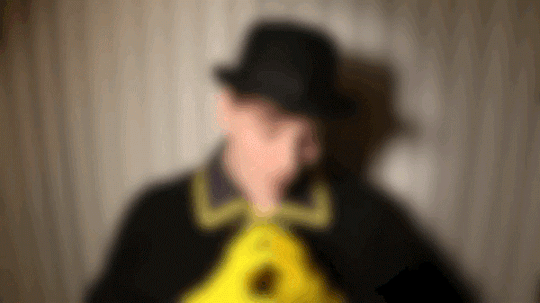
I love everything about this.
Like, what else can I say? This episode is brilliant. It really shows exactly what this team is capable of when they’re at their best. The pacing, the build up, the writing, all of it combined together to make the perfect episode.
Season Two has been, interesting. The long waits have caused some problems with the pacing and characters, not to mention the departure of Joan from the writing team with new writers entering the room, not to mention the first welcome now unwelcome arrival of Asides, and with only the season finale left before season three, it makes me wonder just where this series is headed.
I know this series is capable of doing incredible things, season one is still solid and it really holds up even after all this time. But season two just feels like a jumbled mess. Sure, it’s easy to enjoy the episodes individually, but once you try to fit them all together it’s like trying to jam a puzzle piece into a place where it doesn’t fit.
The best way to describe this season is as an experimental season. Each episode has the team trying something new, sometimes it seems these gimmicks take precedence over the story itself. Of course, some of these can work to the episode’s advantage, while others are just distracting and you’d know you wouldn’t miss them if they were gone.
It’s a mixed bag that’s for sure. One that has me watching in morbid curiosity as I wait to see whether it’ll crash in the end or blow my expectations out of the water. It really is fun to analyze these episodes, and yes I know I can be very harsh but believe it or not this is how I engage with media that I love.
My hope is that team will learn from season two and try to take a more simple approach with their production once season three roles around. Because if they continue at the same pace they are now I doubt there will be many people around to see this series through.
And on that note, that was my ranking of season two! I’m actually kinda excited now to go back and rewatch everything, I hope I don’t have to wait much longer to do so but that all depends on when the season two finale comes. Whether it ends up exceeding my expectations or just being “meh” I know it’ll be interesting regardless and I can’t wait to see just how they plan on wrapping this all up before the final season arrives.
20 notes
·
View notes
Photo
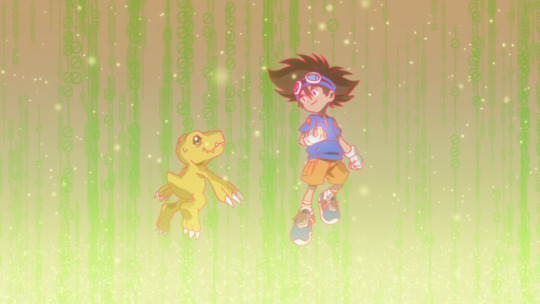
Digimon Adventure:
Honestly, when this series was announced, I wasn’t looking forward to it. While the final product always varies, I’m not a big fan of the concept of reboots, especially in shows like Digimon that live off refreshing themselves every season. Yes, we’ve had continuations of specific continuities a few times, but never a redo of an existing story. I understand it was likely due to ratings, but I’d rather they do a new team in the existing Adventure universe than go back and do the story again.
But, thankfully, I did enjoy it. It had its lows, but a lot of highs, too. I feel like the overall product on an episode-to-episode basis was superior to the original. That’s not to discount the original, as the overall plots there are stronger, and we get character backstories that, while they carry over, are only fleshed out in the original.
The Good: As I said, episode-to-episode, this show is really good, and definitely has the best filler episodes in Digimon so far. While it pops up here and there, there’s a lot less stock footage used in comparison to the previous seasons, and apart from Agumon and Gabumon’s evolution sequences are very short. It also has the best non-movie animation in the show’s run. Fight scenes are no longer stock footage finishers being thrown at each other; there’s actual impact and interaction between Digimon, and a lot less standing around with lip flaps. The battle against Millenniumon in particular was outstanding to watch, and many of the scenes during the fight against Abbadomon were great as well.

Diving into more detail, I like that Taichi was used as a framing character for most episodes. This is a cast of 16 main characters, even if the Digimon don’t get a lot of development, and having a central character, as well as the show’s decision to slowly introduce everyone rather than all at once, makes things easier to digest.
I had heard some complaints early on about how early Omegamon showed up, but when hearing from people who were watching Digimon for the first time it was an exciting mystery and pull to continue watching. And I have to agree with the decision. While I too felt it was a little early, I also thought he was well utilized, and if he helped bring in more fans, then I have to applaud the idea.
While the basic characterizations and backstories are still there, everyone’s personalities have changed ever so slightly. Taichi is less childish than before, Yamato is a better representation of friendship than the original (IMO), Sora lacks a lot of her baggage, Izumi has some self-esteem issues, Mimi is a lot more caring, Joe more confident, Takeru more competent, and Hikari… well, Hikari feels like she’s written as if she’s on the spectrum (which isn’t a bad thing, as it felt somewhat competently done, if maybe a bit subtle and less obvious as the series continued). I actually prefer some of this show’s versions of the characters to their counterparts. Mimi in particular is a far better and more interesting character, and I think the writers thought that too, as she got some of the best solo episodes.

The Bad: While individual episodes are typically good, Adventure: does drag when it comes to overarching plots. It takes them twice as long as the original to fight Devimon, but he isn’t nearly as built up or developed a character until over 10 episodes after they defeated him. Then there’s Millenniummon, who is talked about a lot, but has no personality and is just a force of nature. Granted he has the best fight scene in the series, but that only goes so far. And Negamon is done slightly better? But is pushed aside when it comes to everyone’s individual final character episodes.
A similar issue is that the opening chunk of episodes feel very formulaic. Introduce a new character and have their partner evolve to Adult, then it’s the same with Perfect. Part of this may be because there was a push to get to WarGreymon for promotional purposes, and the several week delay caused by Covid meant they had to get to it sooner to meet deadlines. This show hits its stride after WarGreymon, but it’s more hit-or-miss before he shows up.

While Characters like Mimi became better during the Reboot, characters like Izumi suffered a little, and Sora suffered a lot. It’s heavily hinted that all the character backstories and parent relationships are the same, but they don’t utilize them or bring them up more than once apart from with Takeru. And since Sora’s character development was heavily related to her mom, and her mom was omitted from the series, her development is extremely basic in comparison to the original. Izumi does grow in confidence over the series, but also loses his relationship with his parents and learning that he was adopted. The show weirdly feels like a sequel to the original in this way. There are a few things in addition to parents that carry over from the original, like the crests, that aren’t delved into here, but are hinted at being the same.
Another noticeable change in the characters is that everyone acts quite a bit older than they actually are. Joe is the oldest at 5th Grade, and Takeru and Hikari are, like, 6.The bizarre level or understanding and clear-headed-ness displayed by these children in some of these situations is above what they should probably be capable of, at least near the beginnings of the show. Most of the seasons where the characters are younger do a good job of somewhat realistically portraying their ages, but this season forgoes that. Not a deal breaker, but I would have liked to have seen act their ages a bit more.
Ghost Game: I’m very excited for Ghost Game. Even with the very little I’ve seen of it, it has several things that I’ve enjoyed in previous seasons, like taking place in the real world (something lacking from this season), a smaller cast, and new Digimon. It’s also doing a few new things that have me curious. While having a female Tamer and male Digimon isn’t too uncommon, Angoramon is a more Typically masculine Digimon than we normally see as a partner in these situations, and this is the first time to my recollection that we’ve gotten a male Tamer with a femanine Digimon. Also, Gammamon is the first MC partner Digimon that isn’t a primary color (yellow, blue, or red), which seems to be going around lately (as Zenkaiser and Cure Summer are both white team leaders usually filled by red or pink characters). There’s just a lot of things about the team comp that stand out compared to everything that’s come before if you give it a second glance.
Overall, I enjoyed this season, which I wasn’t sure I would going in. The first half of the show has a few misses, but plenty of hits, and they only increase in number as the show continues. It can easily be viewed if you’re new to Digimon, but there’re also some things you might only pick up if you’ve seen the original. There are also plenty of good individual episodes if you like the original and just want to spend a little more time with these characters.

6 notes
·
View notes
Text

Dust Watched: Magia Record: Puella Magi Madoka Magica Side Story Season 2 - The Eve of Awakening
Genres: (Dark) Magical Girls // 8 episodes // S01 (x)
They really should release the game globally so that I could have the appropriate emotions they’re expecting me to feel. (Also when they actually realise that there are countries besides Canada and the USA, I know, shocking that region locking your game and not advertising it sent it to the junkyard in mere months).
✧ story ✧
I’m going to be honest, I probably should’ve watched the recaps before watching this season because it sometimes took me half the season to realise that I’ve been confusing X character with Y character that whole time. But that’s not an excuse, to be honest. Unfortunately(?), probably half of the memory space in my brain is taken up by anime. I obviously can’t remember the slightest of details years later but S01 of Magia Record came out a year ago and I already couldn’t remember half of what happened in that season. Well, there’s a short plot about Iroha in the first half with Yachiyo and Kuroe (someone from the Wings of Magius) taking the center stage. With the limited cast and easy objective, this half of the anime was quite great and made me expect great things moving forward but Magia Record threw those expectations back in my face. The second half of the anime concerns the Wings of Magius and their big plot for how they’re going to make it so no magical girls turn into Witches. There’s some exposition dumping, a bunch of characters I’ve forgotten about from S01 show up and the issue is resolved in a very... anticlimactic fashion. Add the fact that this is going to be a triology thus making this the always weakest “in-between-story-set-up” installment and you basically have an anime that’s not worth watching by itself.
✧ characters ✧
As I mentioned above, the majority of characters I was supposed to feel very strongly about (according to this anime anyway) I didn’t because I straight up couldn’t remember who was who. I know that the mobile game is a gacha and that means a shitton of characters but this is a SHORT anime. I’m also very much aware that fans of the mobile game would be throwing a fit if their faves were left out but dude... this is chaotic. Upon rereading my review of S01, it seems these characters barely had any meaningful screentime in that season either so it’s no wonder I don’t recall them. Imagine how awkward I felt when I thought a character was a prominent figure in the Wings of Magius only to find out during a conversation that she was one of the main cast in S01. Oops.
✧ art ✧
Now, I know I’m going to be reviewing a lot of anime that most likely has been heavily affected by the pandemic but the art and animation’s downgrade in Magia Record S01 is... very noticable. The problem is that this anime is already compared to PMMM which some even call a masterpiece. Season 1 was already a bit of a downgrade from that and THIS season is even more. The background and enviromental design stayed the most consistent and the characters the least, especially in far-away shots where they resemble stick figures. And PMMM/Magia Record likes to use the method where they zoom in and out constantly so the difference is even more jarring. There are a few fight scenes that they heavily focused on but while they’re very detailed, they suffer from choppiness due to the low framerate. To the point where I literally had no clue what was happening during a fight scene. No, no, no... I would rather they spread the budget out than focused on a handful of sequences.
✧ sound ✧
The OP and ED are quite great although they don’t stand out much. I thought the OST was pretty good as well but then Kalafina’s “Magia” started playing for like 10 seconds and I relaized that, yeah, it could be better.
✧ overview ✧
Don’t watch this anime until the last season is out!!! I realize now that the whole of Magia Record is supposed to be binged or you won’t know wtf is going on. This season also ended on a really important cliffhanger (you won’t remember what it was a year from now). I’m honestly quite sad cause I was looking forward to this sequel but when I saw that it was only going to have 8 episodes, I already knew we were fucked.
My Rating: 5/10
#dusty reviews#pmmm#magia record#magia record season 2#yes im going back to this veeery old reviewing format i used to use#i might ditch it in a few weeks again lmao we will see
5 notes
·
View notes
Text
Gochiusa BLOOM episode 7 impressions
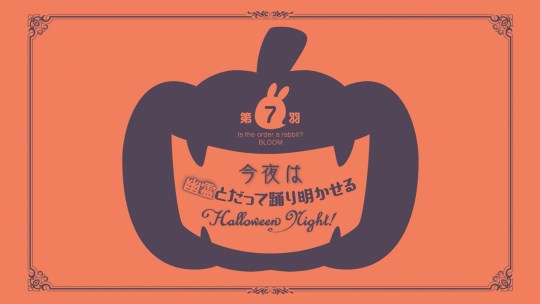
Previously: 6 - 5 - 4 - 3 - 2 - 1
In real world Halloween might have been a month ago, but in the world of Is The Order a Rabbit it’s exactly the season for all things spooky. And maybe things become a little too supernatural for a slice of life show. In the last episode we’ve seen how BLOOM symbolizes the growth of the characters. And as we enter the second half of the season, another meaning is revealed...
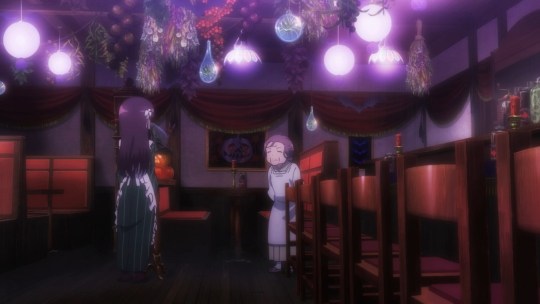
But first let’s visit Ama Usa An, where horror-loving Chiya is decorating the traditional Japanese teahouse for Halloween. Since Halloween is decidedly not a traditional Japanese holiday, it looks kinda surreal, but Chiya’s grandmother is more worried about souls of the dead coming back to life, especially that of Chino’s grandfather (see season 2 episode 9 for more of their backstory). Of course the soul of Chino’s grandfather isn’t actually dead, but is inhabiting the body of a rabbit. It’s not clear how exactly this happened and Cocoa might have been involved.
Speaking of Cocoa, we see her practicing with the magic set she bought in the first episode of the season. She tries to make something appear in her hand, but nothing happens. Clearly you can’t just learn to summon matter into existence in Gochiusa world, or can you? Anyway the shot focuses on a candy laying on a table before the opening sequence cuts in. This must be the object Cocoa has tried to summon and it’s also clearly a foreshadowing for something.
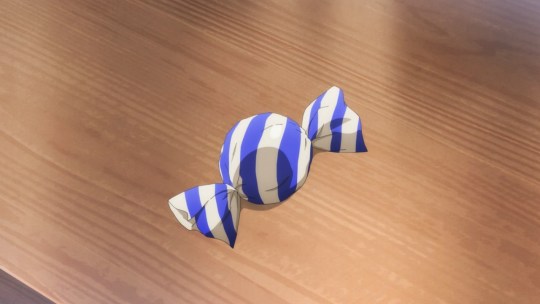
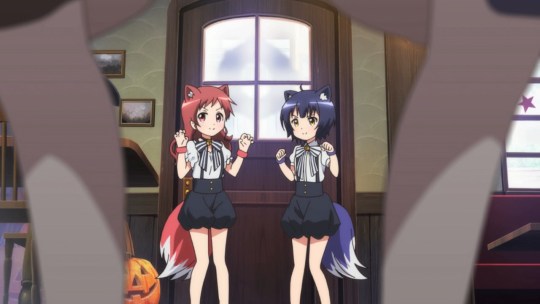
Meanwhile, Maya and Megu are trick-or-treating in matching werewolf(?) outfits hoping to score some free candy. Interestingly the tradition of giving out candy on Halloween has descended from a medieval practice of sharing so-called “soul cakes” which represented the souls of the dead.
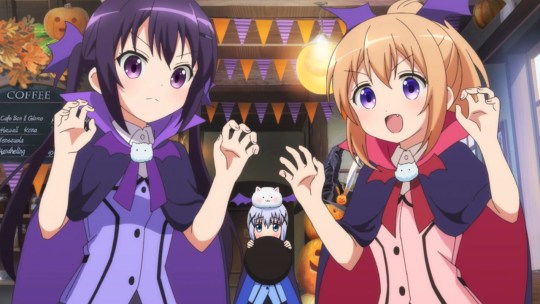
Meanwhile the staff of Rabbit House are dressed as vampires. The theme of vampires fighting werewolves brings up to mind the Twilight series although I’m sure the idea came up many times throughout history. If you look closer, you’ll notice that Cocoa, Rize and Megu have fake fangs (I think Maya’s is natural), although they’re not consistently drawn between scenes, even though in the manga they’re drawn correctly. Maybe they’ll fix this in BD. The only one whose fang is not shown is Chino, and ironically she is the one who actually bites somebody.
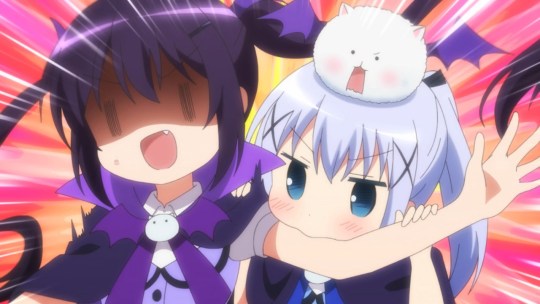
Also the flashback of Chino “roaring” at the mirror reminded me of the scene from Celestial Method where Noel (also voiced by Minase Inori) roars at a dinosaur standee. To be fair it sounds completely different but I just can’t help but compare them.
Also while I was browsing through my copy of volume 6 I found a cute illustration card that seems to be relevant to this episode, but includes Mocha and Cocoa as the wolves and Chino as the vampire (here’s a highres version).
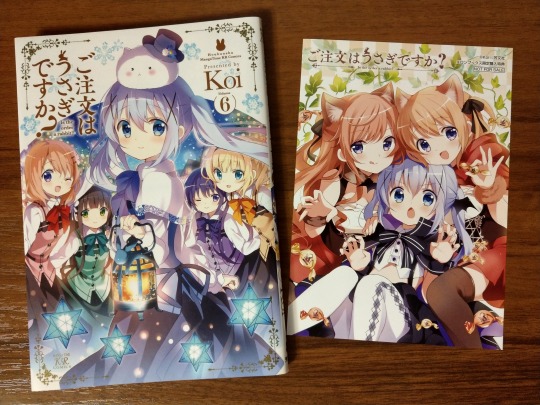
I think I bought this particular volume in Japan on the day it was released. Good times...
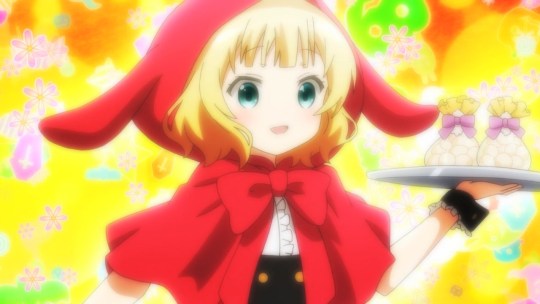
Next MaMe go to Fleur de Lapin and are greeted by Sharo dressed as Little Red Riding Hood (bunny version). This costume appeared earlier in an illustration for the rabbit chapter from the previous episode.
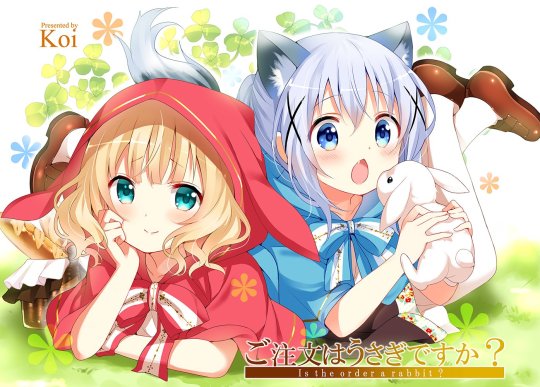
This is also a rare scene where other employees of Fleur de Lapin can be seen, as usually Sharo is shown working there alone. Even in the manga, Sharo is the only employee shown in this scene. In the end it turns out that Sharo is a wolf in disguise and craving for some meat. Which is weird because Sharo hasn’t been shown eating or cooking any meat before.
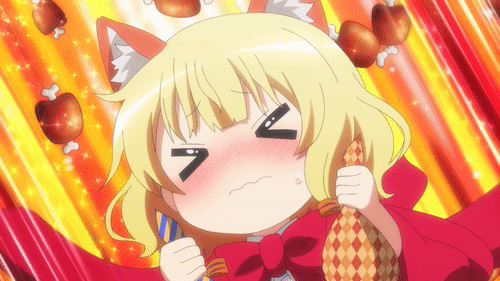
Anyway, next stop is Ama Usa An, which is called the Witch’s Mansion now. Chiya mentions the beginning of the Sabbath, and the manga chapter’s title 今宵は甘兎サバト also mentions the Sabbath. This might be confusing because in Judaism and Christianity the Sabbath is the day of rest and happens weekly (on Saturday or Sunday). However since we’re talking about witches, this actually references the Wiccan concept of sabbat, or one of eight festivals in the Wiccan calendar. In particular, Samhain, one of the four Greater Sabbats pretty much coincides with Halloween and celebrates the beginning of winter.

Chiya does this thing where the protagonist’s hand hurts only to awaken their dark powers, I’m not really sure where this trope comes from but I’ve seen it referenced in anime before and it’s a common chuunibyo stereotype. In this case, Chiya did really just hurt her hand. There’s also some sort of runic circle drawn on her bandages, but if you look closer it says shiratama anmitsu matcha parfait in hiragana.
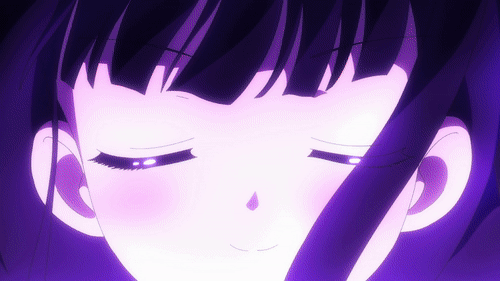
Maya and Megu agree to help Chiya, and become her “familiars”. Even though familiars are better known as a video game mechanic today (which is what the “level up” scene references), witches were associated with familiar spirits since medieval times. A familiar often took form of a small animal, such as a cat. Unfortunately MaMe don’t even know which animal they are, so clearly they didn’t take their backstory as seriously as Chiya did. Their ears and tails look canine to me, so I can see Megu being a fox spirit, but Maya being a cat is less believable. Also during their confrontation Megu confirms that Maya’s fang is her yaeba (snaggle tooth).
As a revenge for the trick MaMe pulled on her, Chiya gives them a selection of pumpkin tarts, one of which is laced with wasabi (which she calls ”Russian roulette”). This seems like a common thing for her, since she did the same with botamochi in season 2 episode 6, and with green tea in season 2 episode 7 (except she used aojiru instead of wasabi). However this time, it was Chiya’s grandmother who put wasabi in two of the tarts, unbeknownst to Chiya. By the way in the manga it wasn’t shown that Chiya got one of the wasabi tarts.

Chiya goes shopping for some pumpkins, but is helped by Rize, and later Sharo gives her anti-pain medications, reminding her of how Chiya tended for her when she was sick in season 1 episode 12. It’s not mentioned in the anime, but Rize also had a “motivation” for helping Chiya, as she hurt her leg before (see season 2 episode 2). Chiya invites Rize and Sharo to dinner and brings up the wasabi-laced pumpkin tarts. According to Chiya the probability of getting wasabi is 1/3. Initially there were 7 tarts, of which 2 had wasabi. Megu, Maya and Chiya eat one each, with Chiya’s having wasabi in it. That leaves 4 tarts with 1 wasabi, so either Chiya’s calculation is incorrect, or somebody ate one more tart.
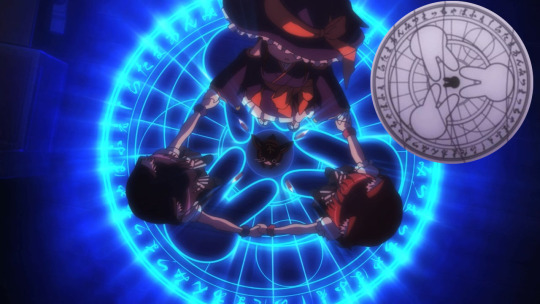
Apparently last day was just a warm up to Halloween (All Hallow’s Eve’s Eve?), so next day Megu and Maya come to Chiya again and try to summon something. A larger and slightly different version of the runic circle previously seen on Chiya’s hand starts glowing and we see that the 3 white rabbits correspond to three people holding hands. There’s also Anko corresponding to the black rabbit in the middle. By the way, in the manga the sign on Chiya’s hand was just a hexagram, and the summoning ritual didn’t have any visible symbols.
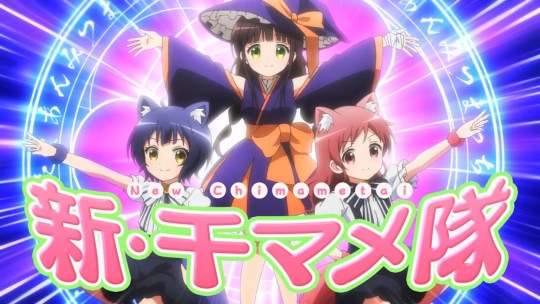
Anyway, they want to summon a messenger from demon world/hell, and coincidentally Cocoa and Chino come in (dressed as vampires) and try to attack (cuddle) them. Chiya, Maya and Megu form New Chimame-tai which works because Chiya and Chino have the same first syllable. However Chi is written with kanji instead of katakana in this version (because Chiya’s name 千夜 is one of the few given names among Gochiusa characters that’s always written with kanji). This defeats Chino, and Chiya consoling Chino like a big sister defeats Cocoa as well.
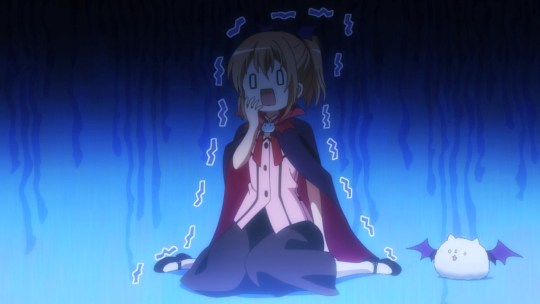
Ok let’s move on to part B, which is the really important part of the episode. The streets of the town are filled with people dressed in various costumes. Cocoa’s classmates can be seen among the crowd, and Aoyama and Rin are enjoying a boat ride on River Sanzu.
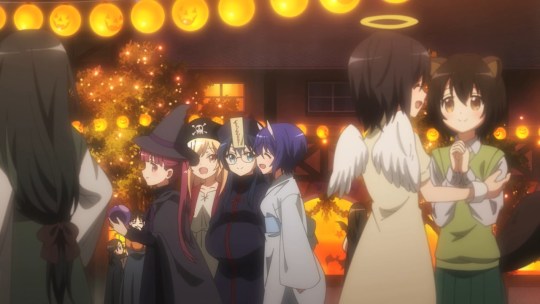
Our main character have also prepared some new costumes for the occasion. First we see Chino, dressing up as Phantom Thief Lapin, while Rize is going as a police officer. Soon Chiya and Sharo join them, who somehow independently of each other also went with a Lapin costume. At least Sharo had a good excuse. For Chiya, Lapin’s gloves obscure the bandage on her hand, so maybe that’s why she chose this costume. But what about Cocoa?
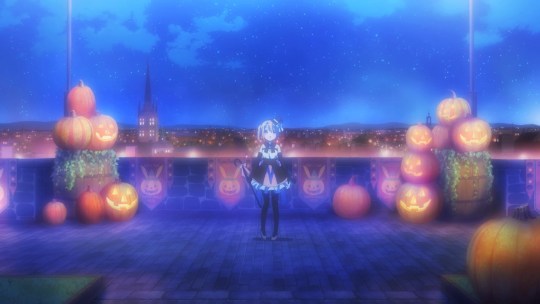
Well, she kinda got lost and we find her at the location that you will recognize if you read my episode 5 review. Cocoa says it looks a little different than usual, almost like a different world (isekai). Well, there’s a lot of evidence to support this hypothesis. First, in a scene that parallels episode 1, Cocoa finds a lost child and tries to calm her down with a magic trick. However you might notice that the child’s head is literally a pumpkin with a moving mouth.

And her mother is also a pumpkinhead. Cocoa doesn’t encounter any other people during this segment, even though you’d think a spot that overlooks the town like this would be quite popular. Well, she does encounter one more person, a mysterious masked magician with an angora rabbit on her head. She also wears a G-clef pendant indicating some sort of music connection.

Now, since y’all had already watched the episode, it wouldn’t be a spoiler to say that this is the ghost of Chino’s mother, Saki. The rabbit on her head is the ghost of the original Tippy before its body was taken over by Chino’s grandfather. The original Tippy was a female rabbit, by the way, a fact established early on in the series. In Sing for You OVA (for which I wrote a not-very-detailed review by the way) it’s established that Saki was a singer and even had a record released.
Anyway, as a ghost, Saki doesn’t speak (although she still can giggle and such) and doesn’t physically interact with Cocoa (only indirectly, by casting candies at Cocoa). Nevertheless she does teach Cocoa how to do the candy trick correctly.
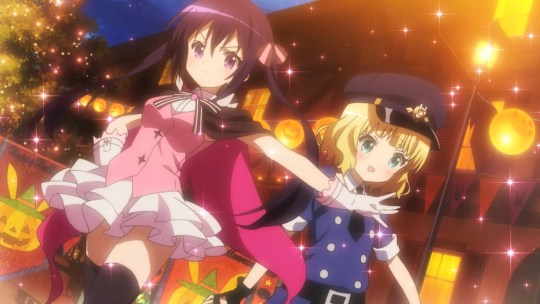
Meanwhile, the rest of the group tries to call Cocoa’s phone but she doesn’t answer. This is another evidence for isekai theory. Cocoa is just out of range, you see. Rize and Sharo swap their costumes (the most unrealistic part of the episode) and Sharo starts “policing” the Lapins on how the real Lapin would talk. Chiya has a bright idea to shout out for Cocoa and call her big sister. However Cocoa would obviously only react if Chino calls her that, so Rize encourages Chino to say it louder (referencing her training for the choir in Sing for You).
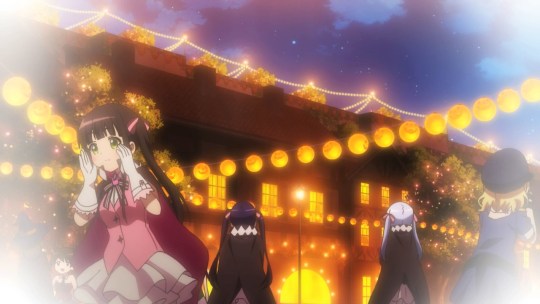
Cocoa and Saki hear Chino, and Saki looks at her daughter from the terrace. Chino also looks up... but doesn’t see anything. She does get a hunch that there’s something up there though, so the group finds Cocoa eventually. Meanwhile Saki feels like her time is up and makes for a quick exit, literally disappearing.

This is where Cocoa returns to the “real world”, as the current Tippy calls out for her. Why was Tippy with Cocoa anyway in the first place? Cocoa looks around and there are in fact lots of people there as expected.
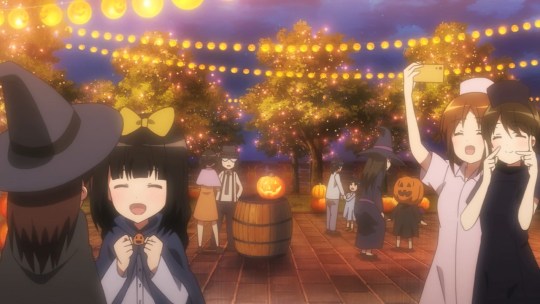
Cocoa thinks that Tippy speaking is an evidence of a ghost, despite her interacting with a real ghost just a few moments before. The 3 Lapins arrive and start arguing who is the real Lapin. Chino says that it’s the one who gets away with everything in the end, implying she will take the whole Cocoa for herself. However Sharo arrests Cocoa for making everyone worry.
On the way back, Chiya recalls the legend which was also mentioned by her grandmother at the beginning of the episode about the spirits of the ancestors coming back for this one day and then returning to heavens. Chino looks up to the sky, while Tippy gives her a solace in the fact that he was once again turned away, implying that he expected to return to heaven with the other spirits.

Tippy also seemed to know what Cocoa was talking about in an earlier scene where Cocoa said she forgot to give thanks to somebody. Just what’s up with Tippy and why is he not allowed to enter Heaven is a big mystery here.
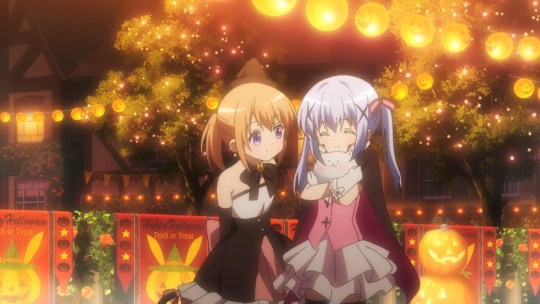
Cocoa also notices Chino being distressed and shows her the magic trick with the candy. It turns out Chino remembers this trick from her childhood, and we get to see a full flashback with Chino’s mother even getting a few speaking lines (delivered by none other but Nana Mizuki). Since the candy was probably a part of the magic set, it’s no coincidence that it has the exact same wrapper in the flashback. The color of the candy matches with Chino’s clothes at the time but you can also think of it as a combination of Saki’s white and Chino’s blue.

By the way, in the manga Cocoa conjures up two candies, and they have a plain wrapping so there wasn’t One Specific Candy like in the anime. Also in the flashback, Chino is carried by her grandfather. His face is not shown, but Takahiro is seen in the background (with Rize’s dad) so by exclusion it had to be him. And in the current scene Chino is the one carrying Tippy like this.
The episode ends with Cocoa asking Chino to tell her more about her mother, while a star is seen rising in the sky, presumably symbolizing Saki’s spirit.

Let’s go back to Cocoa meeting Saki scene one more time. Like I explained, it’s heavily implied that Cocoa isn’t really in the same world as the other characters when she meets Saki’s ghost. Of course Gochiusa had supernatural elements from the start, such as a certain talking rabbit who happens to be Chino’s grandfather. But now we have a ghost of Chino’s mother and Cocoa is the only one who can see her, but Chino can’t? Just what the heck is going on here?
But wait, there is a rational explanation for all of this! Cocoa had a hallucination triggered by all the Halloween celebrations. She imagines helping a lost child just like Chino did before (and told Cocoa about it later) and then imagines the ghost of Saki teaching her magic, because subconsciously she wants to be like Saki. She had seen Saki before on a photograph, but haven’t heard her speak, which is why the ghost can’t talk to her. Hearing Chino call her onee-chan brings Cocoa back to her senses. But how did Cocoa learn the trick if it was just her imagination? Well, consider the fact that she was practicing this exact trick at the beginning of the episode. By the time she shows it to Chino, she has already practiced it a lot of times, but maybe she only realized the crucial part (feint) during the hallucination. Either way, the blue striped candy wasn’t given to Cocoa by Saki, she had it from the start, as part of the magic set! The candies that Saki uses to show the trick to Cocoa all disappear when Cocoa returns to reality.

Saki appears one more time in the bar time scene with Takahiro, who is listening to her record Silver Spoon from Sing for You OVA and then calls her by name. I think this is the only time the name “Saki” is mentioned in the show itself, and it’s not mentioned in the manga at all (unless maybe in some recent chapters which I haven’t read yet). The first time it was revealed was during April Fool’s day Clockwork Rabbit event, as a solution to a “puzzle”. Her name is written in katakana as サキ, however one of possible readings of the word “saki” is 咲き which means “bloom”. Now consider how the last few seconds of the opening animation it cuts from a blooming field of dandelions to Saki:
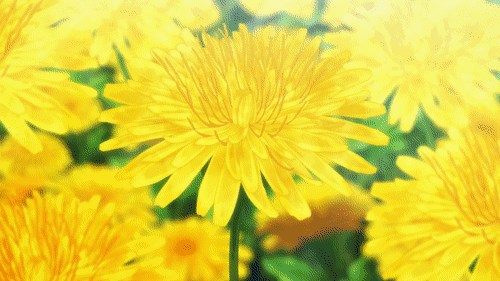
The dandelions connection to Saki was previously seen in season 2 episode 1 and Sing for You. Saki’s character design doesn’t really say “blooming of dandelions” to me, but consider that a dandelion turns into this:

Now that’s more like it! Although it reminds me of Tippy as well. Anyway, that was a very mysterious episode of Gochiusa BLOOM and let’s see what happens next! Only 5 episodes remain...
11 notes
·
View notes
Text
Whisper of the Heart Review
It's not always "what" they do, it's how they do it. There's a scene where Shizuku and her sister are talking but they're in a bunk bed with her sister on top and her on bottom. So Shizuku is just looking up at the top of a moving bunk bed as the voice of her sister. I know it sounds like a small thing but the angles in this movie are really nice, nice cinematography, it makes this world feel lived in. Not to mention they nail the slice of life stuff, they make it feel so real by adding these little details that you wouldn't normally see in a movie, and it makes sure to account for the empty space as well.
Normally that's a bad thing for a movie but this uses it to its advantage. She runs down the street and a dog barks "Can you bark a little louder?" they give a peek at the old man's life before the movie, Yuko says she's not speaking to her father, the mom taking college classes, stuff like that, that isn't essential or contributing to the plot but the world building, the character building. I always hear that kind of stuff about Spirited Away and how the world feels like an actual world you would want to go live in, I just must not have caught it back then so I might need to see it again.
To expand upon that, the shading in this thing is gorgeous, the animation is so nice, it doesn't have that bubbly crying like more recent Ghibli movies have but I consider that a good thing, this is definitely one of my favorite Ghibli movies so far, right under Spirited Away. Also, is it a norm for Ghibli movies to have so many references? I caught quite a few, Porco Rosso, Kiki, Castle in the Sky, a scene very reminiscent of Howl, that's cool that they allude to them, not to mention The Cat Returns is a spinoff of this based on a sequence. I hate seeing that cat, he's not really a full character in this but seeing who he is actually made me reconsider whether I want to see more of him.
One minute they're fighting and the next minute they're buddy-buddy, that's one thing I know about Ghibli, they do that with their characters quite a few times and in a way it's funny.

This is only a bit of a spoiler but the bike scene is easily the best, it takes up the visual representation that he's trying to learn to make violins in order to support them both so he's climbing up this hill with her on the back of his bike and Shizuku isn't having any of that, she doesn't want to be a burden. That's another thing about Ghibli, they normally have strong female characters, Shizuku is no exception, she gets off and starts pushing the bike, helping, she wants to support too by writing to her heart's content.

Speaking of, some of the stuff she says about writing (though little) seems pretty accurate, when her parents are sitting her down, I know exactly what she's going through and how she feels, I'm a writer, I know she is itching to go back and that she feels like her parents are just dragging her away from her goal but that's not even the best of it. So during that sit down conversation, the unexpected happened, they basically say they trust her. I had to pause the movie and look in awe "Did I hear that right? They're letting her go on about it? No contest? No obstacle?" Especially after they introduce the idea that they don't push her to study hard enough towards the beginning, I was shocked they didn't try to play the "We're going to be more authoritative." card. I love it, I really love it, they support her, even though she doesn't want to even tell her parents that she's writing (I get that feeling, I literally do that, I don't show my parents my current projects) that's part of the whole reason I started watching this movie in the first place, the concept sounded really cool, kind of creepy in American standards but still very relatable and the character's drives are inspiring.
31 notes
·
View notes
Note
Hola, no sé si alguien ya te ha hecho esta pregunta, pero ¿por qué elegiste NaruHina sobre otros barcos? Como NaruSaku, ¿dónde es más explícito que Naruto está enamorado de Sakura y que ella comienza a devolver sentimientos, o SasuNaru, donde tienen un vínculo más grande y más establecido?
Translated to English:
Hello, I don’t know if somebody has already asked you this, but why did you choose NaruHina over other ships*? Like NaruSaku, where is more explicit that Naruto is in love with Sakura and that she is starting to return his feelings, or SasuNaru, where they have a bigger and more established bond?
Subsequent asks:
Do you believe that Naruto had a bond with Hinata? If so, how would you prove it?
Why is it difficult for people to understand that stating that Naruto cared about Hinata doesn't deny what he had with Team 7? Or why is it difficult for NH fans to accept that Naruto's first ties were to Team 7?
* As an aside, I feel the need to point out that the Spanish version of the first question used Google Translate so the term “ships” (derived from the word “relationships”, and used in fandom parlance to refer to fan preferred romantic relationships) is translated literally to Spanish, that is: “ships” = “boats” = “barcos”. The thing is, we Spanish speakers don’t use the term “ships” when referring to fan-preferred romantic relationships, and a proper equivalent term doesn’t really exist in Spanish (or at least, not as far as I know, you never know what neologisms will come from the Internet after all). So, we simply refer to them as “parejas” (that is “pairings” or “couples”).
That clarification aside, I stated before I was going to reply to these asks, so here we are. Very belated reply, but I spent most of October and November swamped with work and hadn’t had the time or energy to reply before, especially as I ended extending myself and essentially composed an essay.
So, without further ado, the reply is below the cut. I ended composing it in English as the subsequent asks came in English, so I presumed whoever send the questions was more proficient in that language. I put it below the cut for the benefit of whoever doesn’t want to read my shipping rants:
Regarding why I chose to ship NaruHina over other ships, to put it simply, I just found NaruHina’s dynamic and relationship far more endearing.
At the core, NH is a very tender love story: Two kids who suffer from being looked down and rejected (him by most of the village, her by most of her family), ultimately find mutual support and love on each other. Specifically, I found that the scenes both of them have together during the Chunin Exams arc carried a lot of emotional torque, and those scenes made me fall in love with the couple. Those scenes are also the ones that I would use to establish the bond between Naruto and Hinata, because yes, I do think they have a bond, and is a bond we see blossom as the manga progresses even if (admittedly) is not a bond that receives a lot of focus.
He starts as a snotty and troublemaking brat, the worst student in his class and the village pariah (and a pariah for reasons that are not his fault and were absolutely beyond his control). But in spite of all his mistakes, he never surrenders and persists on making reality his impossible dream, no matter what everyone else says. His courage and determination end catching the eye of this quiet, timid girl, who is rejected by her family due to her lack of strength. Her admiration for him inspires her to become braver and stronger, and in the process she adopts his nindo (“I’ll never go back on my word”). Ultimately, said admiration also ends blossoming into love.
At the third Chunin Exam, after seeing Neji trying to demolish Hinata’s confidence with cruel words (cruel words that ring far too close to home for him), Naruto cheers on her, which motivates her to confront her fears and battle Neji in spite of her cousin surpassing her in skills by far. Hinata’s courage and determination during the fight end impressing Naruto in spite of her defeat. Neji’s brutality also motivates him to avenge her honor (and with a blood vow, no less), as he feels kinship with her.
Before the fight with Neji at the quarter finals, Naruto feels down as his opponent is really strong and, in spite of all his training, he is not sure that he can actually defeat him. By chance he ends running into Hinata. She thanks him for cheering on her previously and muses that she is finally starting to change a little and likes herself more now. At her words of gratitude, Naruto drops the bravado and turns sincere with her, revealing that in spite of his boasting, he doesn’t think a “failure” like him who is always making mistakes can defeat a genius like Neji.
In response, Hinata proceeds to encourage him, stating that what she admires of him is not that he is perfect, but rather that in spite of making mistakes and failing he has the ability to rise and try again. She considers said ability true strength, hence why she considers him a very strong person, or a “proud failure” as she calls it (and incidentally, this is another detail that makes the ship endearing to me: Hinata is among the first few people who sees beyond Naruto’s flaws and realizes his true worth). Her words end cutting deep into Naruto (just the way he looks at her completely wide eyed shows how much she affects him) and help him to recover his determination. He leaves to face Neji but not before thanking her, stating that while at first he considered her a weird and plain girl, she is actually “a person [he] truly like[s]”.
Later during the fight, after Neji explains the tragedy of his past and the reason for his fatalist outlook on life and destiny, among his rebuttals of said outlook Naruto calls Neji out for his treatment of Hinata, pointing out that Hinata also suffered like him yet still was desperately trying to change her own fate (thus showing us that Naruto also understood Hinata’s plight). Finally, after the fight and Naruto’s victory, his first thoughts while basking on the audience ovations are (at least in the manga): “Where is Hinata? Did she saw that?” (Of course, Hinata is unconscious at this point due to her prior injuries acting up when she saw Neji injuring Naruto, but that’s a bit beside the point).
As you can see, in that entire sequence of events mentioned above is shown that they end forming a bond in their mutual understanding and support of each other, as well as in their shared nindo. It’s not a bond that receives a lot of focus later in the story, admittedly, but it’s still there and later developments in the manga don’t really negate it. Indeed, we end seeing a couple of actually significant story events that ultimately reinforce it.
I’m talking of course of Pain’s invasion of Konoha (when, while trying to save him from Pain, Hinata confesses her love to Naruto, explaining how he inspired her to change and become better, then Naruto goes straight to Six Tails in rage after watching her being injured by the villain) and the battle between the Shinobi Alliance versus the “Uchiha Sith Lords” and the Juubi (when, after seeing Neji die in battle while protecting him, Naruto is about to surrender to Obito’s rhetoric due to failing to protect his friends, yet Hinata stops him and encourages him again, helping him recover his fighting spirit while telling him that his feelings for his friends were not a lie and pleading him to not let Neji’s death be in vain). Both scenes also have a lot (and I mean, A LOT) of emotional torque, and reinforce the theme of mutual understanding and support that runs in the ship. On the whole, it’s a really positive bond, as it essentially drives both characters to uplift each other.
Now, while there is some of that NaruHina dynamic (“mutual understanding and support of each other”) in the other two ships that you mention (NaruSaku and SasuNaru), there are also things regarding their respective dynamics in the canon that make them… well, far too troubling for my personal taste.
In the case of Naruto and Sakura, their relationship dynamic (especially in the anime adaptation) resembles a lot the typical “Tsundere” dynamic that you see in a lot of manga and anime: A protagonist who has a crush or is in love with a girl with a bad temper, with said girl always punching him out every time he tries to woo her (or otherwise does something stupid or perverted in front of her), although she gradually warms up to him as time passes. I have to clarify that, strictly speaking, I’m not really against that kind of relationship dynamic in anime and manga (indeed, I like a few ships in other series that have that kind of dynamic). However, in the case of Naruto and Sakura, I find that dynamic pretty troubling, primarily due to Naruto’s backstory, hence why I never shipped them in a romantic sense (although I must add that I do like their relationship at a platonic level, as they do have a couple of pretty tender scenes together).
I might also clarify (pertaining to how you phrased your question) that while Sakura does warm up to Naruto as time passes and starts considering him a good friend, in the manga it’s never explicitly show at all that she starts to return his feelings. At most it’s only briefly implied during the early arcs of part II, but the “fake confession” scene during the Iron Country arc essentially throws the possibility by the wayside.
As to Naruto and Sasuke… well, first it’s important to recognize that the manga’s author never intended their relationship to be seen in a romantic way, but rather as a sibling-like relationship. Of course, that doesn’t negate that their bond is central to the storyline, neither that it receives a lot of focus for most of the manga and it also has scenes with a lot of emotional torque. All of that inevitably leads to shippers pairing them together in a romantic way, regardless of what the author’s intentions were.
That being said, while there is also a theme of mutual understanding in their bond of brotherhood and rivalry that also drives them to uplift each other, the problem is that… well, to put it bluntly, their relationship becomes extraordinarily toxic for a pretty big chunk of the story. I mean, seriously: For most of part II of the manga (and most of Shippuden in the anime), Sasuke becomes a massive cretin and jerkass that treats his loved ones (including Naruto) like garbage, causing them a lot of emotional pain and strife. Sasuke also tries to murder his closest friend in multiple occasions and Naruto literally has to give an arm in exchange before the Uchiha finally has a moral epiphany and decides to change his ways. Given Naruto’s backstory, once again I find that dynamic extremely troubling and distasteful, hence why I’m not fan of pairing them in a romantic way.
(I might probably also add that it’s because of the above paragraph why I’m not really fan of SasuSaku either. I have made my peace with that pairing mostly because Sarada is one of my favorite characters in Boruto).
As to your final question… well, I can’t speak for everyone in the fandom neither want to make any generalizations, but from what I have seen around online, it seems to mostly boil down to classic fandom rivalry.
Naruto ran for almost 15 years with the characters locked in a messy love dodecahedron that the author didn’t intend to resolve until the very last second. During that time the different fandom factions that formed around every ship obviously came to blows, with rivalries and grudges forming. The net result is that a lot of people in the fandom have become extremely hyper-defensive regarding their preferred ships, with some people often overstating the importance of certain bonds while simultaneously minimizing other bonds. You certainly see it happen in all the shipping fandoms: There are some NaruHina fans that minimize the importance of Team 7 bonds with Naruto, as well as some fans of ships involving members of Team 7 who take issue with the notion of Hinata also having a bond with Naruto.
It doesn’t help that some fans (usually very young ones) have a very… well, “immature” understanding of love and relationships: Falling in love with someone shouldn’t mean that suddenly all your other relationships become “lesser”. Thus, the fact that Naruto fell in love with Hinata in the canon of the series doesn’t mean that his bonds with his team mates, friends and teachers no longer matter. On contraire, all of them are important in different ways.
6 notes
·
View notes
Text
Best of DC: Week of February 26th, 2020
Best of this Week: Batman: Curse of the White Knight Book Seven - Sean Murphy, Matt Hollingsworth and AndWorld Design

Batman is Dead.
The last issue of Curse of the White Knight gave us the last in the story of Edmond Wayne and revealed that the man that Bruce thought was his ancestor, turned out to have been the family to Jean-Paul Valley instead. Bakkar of the Order of St. Dumas killed Edmond after betraying and stealing Gotham from under him, thus assuming the name of Wayne and forming the city to his vision. With this newfound information, Batman has found himself a man with a lineage of thievery, especially after finding out that Gotham’s Elite have been funding their crime through Wayne Enterprises.
This issue begins with a somber flashback to a moment before the funeral of the Waynes. Bruce cries and blames himself for their deaths because he wanted to see The Mask of Zorro. He had always wanted to use the rapiers that his father kept on display and figured if he learned to use them from the movie, then he would be able to impress his father enough. Alfred, always so caring, tells him that if he’s able to go to the funeral, then he can hold a rapier. He then vows to teach young Bruce how to use it for the next danger he may face.

Matt Hollingsworth colors this flashback in a cool blue hue, emphasizing both the sadness and the hopefulness of the moment. Murphy portrays Alfred as being caring and shows that even with the tears, Bruce shows his ability to rise up and become the hero that people need. Though the rapier is far too large for his kid body, Bruce holds it firm in hopes of protecting Gotham in the future.
As we cut back to the modern day, Bruce faith in himself and his dreams of becoming Gotham’s knight are shaken. He was never a Wayne by blood and he sees himself as part of Gotham’s cuse. Many would be right to see him as such given Gotham’s crime initially started off as petty stuff and eventually escalated into battles with The Joker, Two-Face and others with Gotham being caught in the crossfire every time. He didn’t even know that his company was being used by criminals because of his singular focus on fighting crime.
Murphy draws Batman as being tired and ashamed of himself for only just now understanding Jack Napier’s vision and why Batman is just as bad for Gotham as The Joker was. His expressions are melancholic, Murphy makes excellent use of shadow to try to hide some of his shame and body language to make him look like an old man that’s been sitting on a lawn chair for eighty hard years. Harleen Quinzel acts as his voice of reason during his pity party and actually shows concern for him.

Harleen has been a central character in this world since the very first issue of the original White Knight and that doesn’t change here though her own personal arc is over. The last issue saw her do her best to bring Jack Napier out of Joker’s mind for one last time for information and to save her children. In the end, she had to shoot Joker in the head to let Jack rest and rid herself of the monster that had been plaguing her for years. She still finds herself at Batman’s side as one of his most trusted friends.
Bruce still has one thing that he can do to make sure that Jean-Paul doesn’t get away with his crimes and Harley convinces him that Gotham will forgive his transgressions like they did for the former Joker in Napier. At the same time, Azrael is still out there and Murphy and Hollingsworth give readers an AMAZING shot of the villain in his updated Knightfall costume. He grabs onto the nds of his cape as he soars backwards into his hideout. The lights of the city contrast with his blacks, yellows and blues to just give us a pretty damn good shot of how powerful he feels in the suit.
This is contrasted by the next few set of panels where he’s puking out of his mask after escaping from the GTO (Gotham Task Oppression Unit). This version of Azrael has been diagnosed with terminal cancer and as such needs medicine to live and suppress the symptoms. With little dialogue and some telling panels, we see that Azrael has empty bottle after empty bottle of pills in his cabinet. He’s starting to look a bit more gaunt than the first time we saw him. He’s withering away slowly and only has one more pill to spare for his coming battle with Batman.
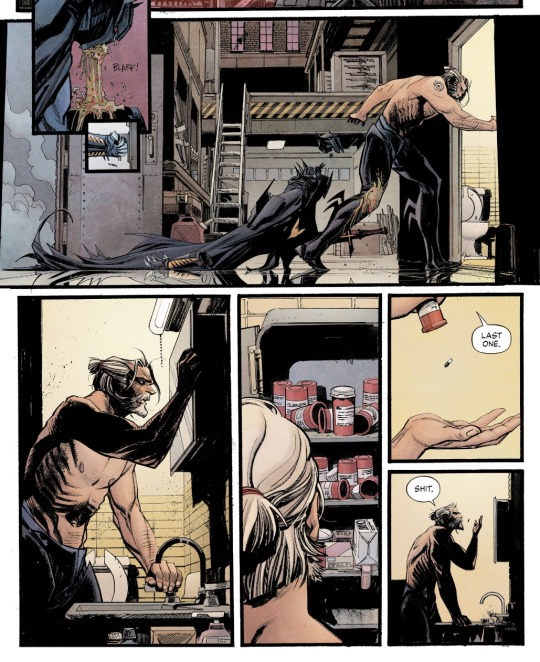
I love the details that Murphy and Hollingworth add here. There’s blood in his vomit and it maintains after he pukes on his leg. His ribs are starting to show and we’ve seen just how jacked he was in the issues prior. His hair doesn’t appear as long as it did, even pulled into a bun/ponytail and there’s just something so final about the “shit” he gives after finding out that he only has one more pill left. In that singular moment, his mistakes come back to haunt him after killing his, admittedly, treacherous employer.
Soon after, Bruce makes amends to Barbara Gordon after inadvertently causing the accident that almost saw her completely lose use of her legs and effectively getting her dad killed. Barbara has always been resilient and we all feared that that issue #5 would be yet another Killing Joke, but here she is, using crutches to try walking again. The scene takes place during the bright Gotham day and this signals a brighter future for their relationship.
Bruce had always gone to Jim Gordon for advice on what route he should take, but without him, Bruce is missing one of his moral compasses. Barbara is the next best person because she has always been smarter than her father and Bruce has a ton of guilt to get off of his chest and Barbara handles everything like the mature adult that she is. She doesn’t blame Bruce for what happened, even though she said horrid things in anger, but can anyone blame her? She cries at the mention of her father and embraces Bruce, encouraging whatever his decision may be.
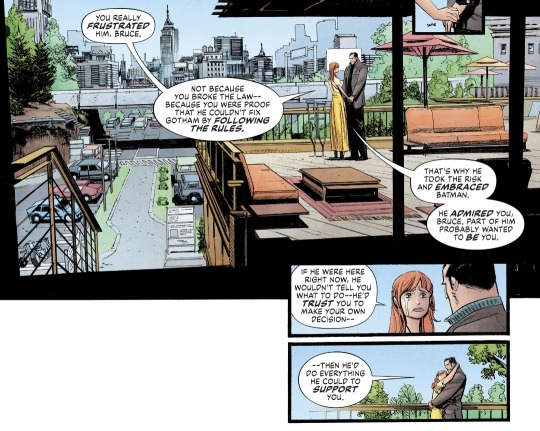
Of course, with this being the penultimate issue in this particular storyline, it only makes sense that we see a grand revelation come out of it. Murphy and Hollingsworth set the stage with Hollingsworth coloring the afternoon skies of Gotham with an orange-red kind of hue. We see various shots of different places in Gotham from public libraries to the streets themselves as Batman appears on the giant monitor of Gotham Square. Everything feels hot and sort of uncomfortable.
Bruce gives his appreciation and thanks to the people of Gotham for allowing him to serve as their protector and we continue to get these various shots of people. There’s auto mechanics watching the broadcast in their shop, people in a bar and kids watching on a cell phone with their dog. Murphy uses this to illustrate that Gotham is far larger than we think it is and that there are many people that Batman has saved from every corner of his beloved city, but he hasn’t done enough yet. So what’s the final step?
Batman reveals himself to be Bruce Wayne and dismantles WayneCorp.

Bruce finally becomes the knight that Gotham needs by giving back to the people. By destroying his company, he gives back to the people of Gotham by giving all of his money to nonprofits, schools, homeless shelters etc. It’s everything that Batman detractors have been saying Bruce should have done for ages. In doing so, he offers Gotham a better future than he could have as Batman, but he only asks them to stay off the streets of Gotham for one night while he takes care of the Azrael business. Murphy shows Bruce holding his cowl one last time, standing tall by his heroic decision.
Back at the GCPD, he gets lambasted by Commissioner Montoya for going off and doing his own thing again, but counters by saying that he trusts in the people of Gotham and they all formulate their battle plans. It’ll be his last time taking the reigns before he turns himself in as well, so he might as well make sure that everything goes according to plan.
As Montoya tells Batman that Azrael destroyed most of the other Batmobiles in his assault on bruce in Book Four (I think), she reveals that one survived and I see that Sean Murphy is a Batfan after my own heart. The Batmobile that survives is the badass one from the Animated Series, what this book is supposed to be the “sequel” to. It's sleek and well designed thanks to Murphy’s own love of cars. From the presentation, readers can tell that this is one of the pages he took serious time with as the Batmobile is given so much respect.

After a short conversation with Dick about what Bruce is going to do when he catches Azrael, Batman drives away, leaving his sidekicks concerned about his state of mind and we get one last splash page of Batman standing in the middle of Gotham Square without his cowl and the sky is a blood red. The Batmobile looks sexy in the background and this was all just so amazing.
Sean Murphy is a comic book treasure. His art and his writing truly made this an experience and a Batman story worth standing the test of time. It had the action, the drama, the stylish sequences and several twists and turns that make a story great. He’s made Batman his own in a grungy style much like how Scott Snyder and Greg Capullo have in a heavy metal manner. Murphy’s Gotham is a masterpiece in crustpunk with social problems that Batman’s always had in the periphery of his character and every issue has been better than the last.
Matt Hollingsworth brings it to life with his perfect colors; Whether they’re making use of the blues of Gotham’s clear skies or the light purples of the night sky, Hollingworth makes Gotham look distinct no matter the time of day. Scenes are given hues to match the tone of the pages whether they’re full of intense anger or incredible sadness, Matt Hollingsworth sets the mood no matter what

I really enjoyed this series, but I can’t wait for the next and final issue of it just to see that confrontation between Batman and Azrael. It’s been a long time coming and the fallout from Bruce’s decision as well… it’ll be too much, but yeah High recommend!
Also, support me on Patreon:
patreon.com/TyTalksComics
#batman#curse of the white knight#azrael#barbara gordon#harleen quinzel#sean gordon murphy#sean murphy#matt hollingsworth#dc comics#dc black label
28 notes
·
View notes
Text
Healin’ Good Precure Episode 01
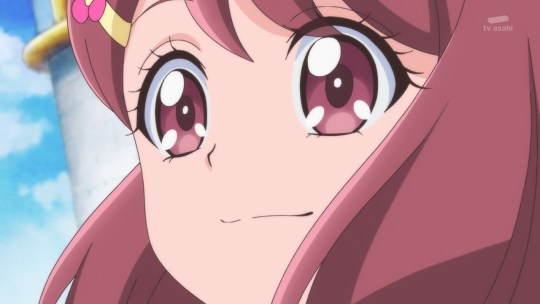
I'm feeling really good about this.
The time has finally come, Healin' Good Precure is among us and I couldn't be more happy about it! I watched this episode twice and my liking for this season just kept growing and growing, I know it's very early to say this (there are at least more 46 episodes for me to change my mind) but I really am in love with this season already.
I believe this is my first time covering a first episode on its own and I don't really know how to do this so if it seems like I keep going back and it seems that I'm just running in circles please bear with me. XD
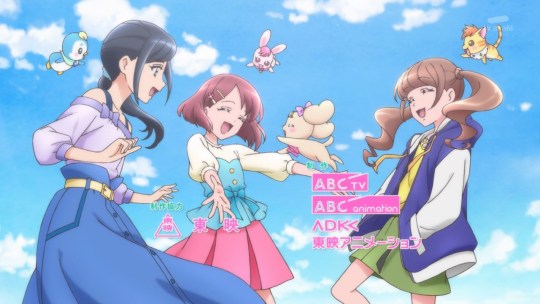
I think to begin with I'll take the obvious things out of the way and first talk about the OP, the ED, the transformation, and the attack before going into my opinions of the episode itself.
This is gonna sound repetitive but I LOVE THE OPENING AND THE ENDING. More so the ending than the opening, but I love them both, they are very strong on the visual side.
What I like about the OP is that it's a pretty soothing yet energetic song that fits perfectly with the Healin' Good atmosphere, I also love the visuals they look very beautiful, very fun, I got a very light-hearted vibe from the shots of the girls in their civilian lives, and it made me feel like I already know these character for a long time and I really care about them. I'm gonna be a little controversial here and say that the part people liked the most of the OP is actually my least favorite... I know it's a beautiful work of animation and it does look amazing but I wish it was more concentrated on the action scenes, they could've done the overlay on another section of it IMHO. It doesn't ruin it though, I still like this op quite a lot. Also, I saw some people comparing it to Star Twinkle's opening song but I think it's an unfair comparison seeing how different both seasons look, I know in the end it comes to personal preference but I think the Healin' Good opening is perfect for it in the way it is just how Star Twinkle's opening was perfect for it seeing how it was a more quirky and fun season.
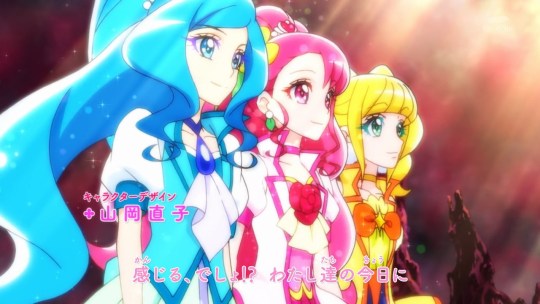
Talking about the Ending, the CGI there looks awesome but I do think the camera movements are a bit too hectic, I think they were aiming at something more dynamic, and it does feel like that, but I feel like it's kinda hard to keep track of the dance moves at some parts. But I think the song is so good and the shots are so beautiful it's kinda forgivable this small confusion. I thought precure couldn't top PaPePiPu Romantic and Please tell me...! Twinkle but I was wrong and I'm already hooked on Miracle Link Ring on a way I wasn't expecting to be.
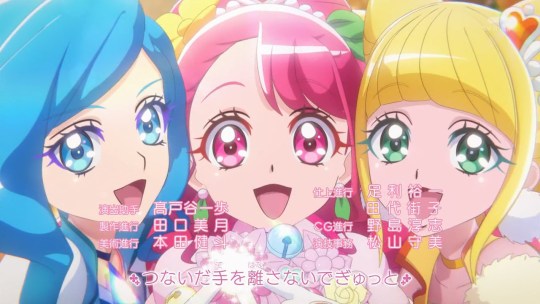
Now going into the stock footage stuff, I love Grace's transformation and attack. I've seen people complaining about how short both the transformation and the attack are but to me that's not a problem, I know we came from a season where the transformation was very big and there was a lot of scenes and everything, but I usually like shorter transformations more, they have a certain charm to me that long transformation sequences usually don't have. One thing I really like about this one is when the white coat appears kinda like a cape and it wraps it around to create the main outfit, I think that a very nice detail and it's also a part of the cure's designs we missed noticing, their vest is actually simulating a doctor's coat and that's very cool to me!
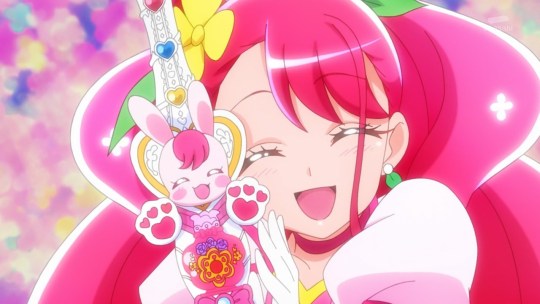
Talking about the attack, it was way simpler than I expected it to be, which on itself isn't really a problem, Leo pointed on his reaction video that it looks like this attack is more easy to be used outside the stock footage sequences which can be quite interesting for the action portion and I agree with that, I also like the ode to Floral Power Fortissimo with the beam punching a whole in the MOTW and taking the Element fairy like a flower heart, and I love the final shot with Grace facing backward and saying "take care", I always love when precure does something like this, but if I didn't say I'm a bit disappointed I'd be lying, I wish it was a bit more detailed.
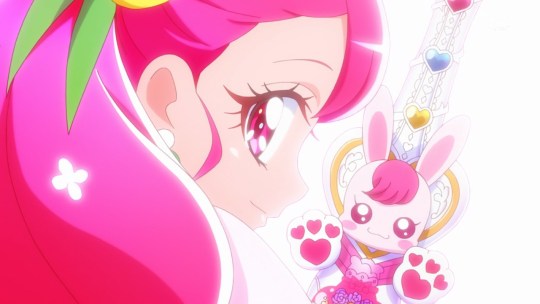
With the formalities out of the way let's get into the episode itself.
To start things off I really like this city, it seemed like an unusual setting from the descriptions we had, but I like how this is kinda like a touristic/spa city with all those places for different kinds of treatment and the hot springs and all, it makes a lot of sense Nodoka's parents would eventually move to this city.
Speaking of Nodoka herself, she's a real sweetheart. From the trailers we got it seemed like she'd be more of the calm type but she's actually quite energetic and she's more than ready to help other people when they need, she's very pure. And it's very comprehensible that she was this way since she was bed-tied for quite a long time (I assume), I don't know if this was in her profile and I missed this detailed but I was really shocked when they cut to that flashback and she was in a hospital bed, I think this is the first time precure has done something like this for a main cure and it really intrigues me to see how they gonna use this as part of Nodoka's development.

We got to see Hinata and Chiyuu in this episode as well and while their participation was really short I think it was enough to make a good first impression of who they are. Hinata was WAY MORE energetic than I was expecting, I love her, I also love how she broke the tradition and for the first time (I believe) the lead cure bumped heads with another character that wasn't a fairy XD I'm so excited to see more of her. The Chiyuu interaction was very unexpected as well, I knew Chiyuu was athletic and all but she seemed very calm and polite and I thought her first contact with Nodoka wouldn't be in the midst of her training, so I really like that this was our first impression of her to kinda set her apart of her blue comrades of this franchise.
The fairies this time around are quite interesting, they're full of personality and I think they'll be a great addition to this cast. Rabbirin I think will be the fairy that will be harder to connect with, not because she's a bad character but because I sense some level of stubbornness on her that can be a little annoying at times, you know seeing how keen she was on how her partner SHOULD be and seeing that she refused Nodoka's help until the last moment didn't do a huge favor on her likeability but I'm interested in seeing how they will develop her character. Pegitan was the least fleshed out of the fairies and I hope that this was like that because of his shy personality rather than the show overlooking him. Nyatoran also didn't do a lot but since he's more of an outspoken extrovert he left more of an impression on me than Pegitan did and I'm quite liking him, I hope they don't screw his character because I don't wanna hate on the good cat boy. Surprisingly enough, I think Latte was the one that was left behind the most even though she's the main mascot, maybe it's just me but she didn't really leave that much of an impression on me like the other healing animals did (and yes, I'll call her Latte until we see another merch with her name romanized to confirm if Rate is the correct pronunciation or if it was just a fluke).
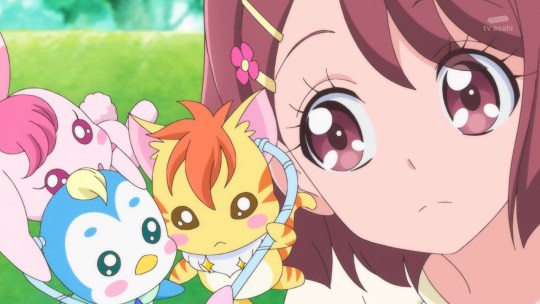
The villain, Daruizen, didn't leave much of an impression too because he didn't do a lot, he summoned the MOTW and taunted Rabbirin but other than that he didn't do much, we also don't know what his evil team is or what their goals are so I don't really know what to think of him yet. Though I really like the summoning sequence and the concept that the MOTW is a little virus or germ that infects the Element spirit making nature sick, I'm really excited to see what they can do with it during the season.
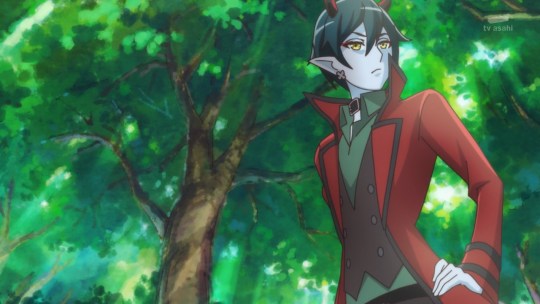
I think my biggest criticism of this episode is how short the fight was. I was really enjoying the episode through and through, Nodoka's introduction was cool, the scene in the Healing Garden was interesting, I loved when they drew the parallel between Nodoka and Rabbirin at the beginning and then before the action started they drew another parallel between Nodoka and Daruizen with them saying the same phrase with different intonations and meanings, I was really apprehensive seeing the fairies trying to stand up against the villains and that moment where Rabbirin gets trapped under that tree and everything, but then Nodoka transformed and it kinda killed my mood because the fight was short and Rabbirin kinda narrated everything and that took me off from the experience a bit, I think this fight should've lasted longer and only be concluded in the next episode, especially to show more of Rabbirin not trusting Nodoka's abilities to have a good basis for the next episode.
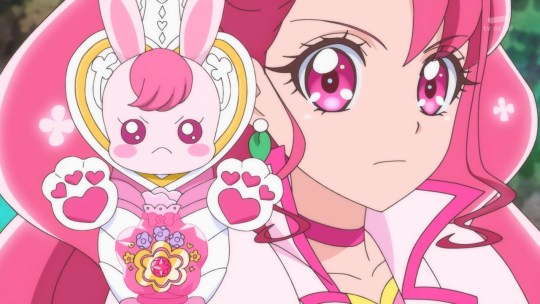
But despite all of this I still had a very good time with this episode, I think this is will become one of my favorite first episodes of the franchise and I'm more than ready to follow this team through this year and I'm very hopeful that this will be a good season (I hope I don't bite my tongue on a few months XD). What are your thoughts on this episode? Let me know in the comments. I'll see you all in the next time. Healin' Goodbye~
14 notes
·
View notes
Text
I went to see the "Mewtwo Strikes Back: Evolution" premiere at Anime-Expo!
Hey, everyone! I just returned from Anime-Expo where I was lucky enough to've seen the world premiere of the 22nd Pokemon film, Mewtwo Strikes Back: Evolution. Wanted to share some of my experiences on it!
I'll start with some information about the event, before going into details on the movie itself. First of all, this was (as far as I understand) the very first time any Japanese-language with English-subtitled Pokemon animation has been officially (and legally) released in North America (and possibly outside of Japan in general?) so I wanted to make sure I attended this pretty momentous occasion. The event itself was handled very well by the staff and there was a great bilingual host who oversaw the whole thing and really hyped up the audience. After the film screening was finished, the three related guests of honor, Kunihiko Yuyama (co-animation director), Motonori Sakakibara, (co-animation director) and Rica Matsumoto (Japanese voice actress of Satoshi/Ash) were brought to the stage to answer a few prepared questions and audience questions. Afterward, Rica Matsumoto performed "Mezase Pokemon Master" live for the audience, which was an absolute treat. Finally, after the reveal of Armored Mewtwo's upcoming appearance in Pokemon Go, we took a "family photo" with a mascot Pikachu making an appearance! The whole thing was a total blast.
Some key points involving the Q&A session:
Rica Matsumoto was in particular very excited to visit LA, especially because she had worked on the Japanese dub for Beverly Hills 90210 and got to visit the real location after wanting to for so long! In addition, she was so taken aback by the audience's enthusiasm for "Satoshi", knowing how they were far more familiar with "Ash", but felt a strong connection to them through the character and Pokemon in general. The two animation co-directors Mr. Sakakibara and Mr. Yuyama shared similar comments, being blown away by the audience's emotional reaction. The screening also gave them major nostalgic flashbacks to first working on the original over 20 years ago. They were also so grateful.
I was fortunate enough to be chosen to ask the first of the three audience questions. First, I thanked them for giving us the opportunity to see this film in its original language with subtitles, as this was a tremendous honor to begin with. After mentioning that the American fandom was very appreciative for the English dubbed version of the TV series and movies, I asked if they would be able to give us any other future opportunities to see ANY other Japanese-language Pokemon animation down the line. Mr. Yuyama said they have plans, with Rica Matsumoto following with "Count on it!!" Nothing further than that, but definitely a good sign!
The next question from the audience asked about a trailer featuring footage involving what appeared to be an older version of Misty, why it was cut and what its involvement was to the movie's early stages of development. Mr. Yuyama simply responded with (paraphrasing, here) "While that was meant to show the image of an adult, the character in question was not actually an older version of Misty. The haircut is very similar though, I can see why you would make that mistake!". Rica Matsumoto adds (again, paraphrasing) "It just goes show that there's so many pretty girls in Pokemon, it's easy to mistake them for each other sometimes!" (Personal note: obviously this is sort of 'dodging the actual question', but it's likely they either weren't allowed to go into detail as to what that early trailer was all about, or possibly forgot about the details since it had been so long ago.)
The final audience question asked about what led to the decision to re-do the original film with CG animation. Mr. Sakakibara mentioned that they had wanted to do a CG Animated Pokemon film for a long time, but thanks to the collaboration with the 3D animation studio they worked with (I've forgotten the studio's name unfortunately, sorry!) they were able to finally make it happen. They chose Mewtwo Strikes Back as the experiment piece in order to try pushing the original character animation even further with the expressiveness and emotion.
I'm sure fans of her know this already, but Rica Matsumoto is an absolute ROCK STAR on stage. She loved teasing the audience and getting them amped up, commanding us to get louder and louder! "When I say 'Pokemon', you say 'Getto da ze!'" was a real highlight. To her, "Mezase Pokemon Master" is THE defining Pokemon song.
Next, I'll talk about the film itself. To those of you who don't want to be potentially spoiled on some of the differences between this and the original movie, skip this part!
The subtitle track for the film used all of the official English names of all characters, including the humans, Pokemon creatures, attack names, locations and even the nicknames of the guest characters' starters ("Bruteroot" and "Shellshocker"). For the most part, the translation was very close to the original Japanese dialogue, but there were definitely a few liberties taken at times. Team Rocket's motto was changed to reflect the English adaptation ("Prepare for trouble and make it double" etc.) along with referring to Ash/Satoshi as "Twerp" (instead of "JARI-BOY!"). There was also a very obvious 'joke' on the translator's part involving a new scene where Brock/Takeshi hits on Neesha/Sweet, proclaiming something about his "jelly donuts" (ending in the ol' Misty-dragging-him-away-by-the-ear gag). As this scene had completely new dialogue, I wouldn't be able to cross-check whatever the 100% accurate translation would be off-hand. A couple other liberties taken (in a way), were that certain lines throughout the movie were word-for-word 'translated' as lines from the original English dub of Pokemon: The First Movie. Thankfully these were rare, but one that definitely sticks out was the "I see now that the circumstances of one's birth are irrelevant. It is what you DO with the gift of life, that determines who you are." at the film's climax. Lastly, Mewtwo's words asking "Was I created by God?" and the scientists' response, were adapted in the subtitles as "Was I created by nature?". (Personal note: Likely this was to avoid flat-out religious references.)
The film begins with Dr. Fuji and his crew retrieving the Mew fossil from the ancient ruins. The "Birth of Mewtwo" sequence involving Amber/Ai is NOT included in this version of the story; the following scene leads directly into Mewtwo's awakening in the tube, to which the movie plays out as you remember it.
Dr. Fuji's laboratory is tremendously redesigned, but the same events transpire.
Mewtwo's armor is, as you've noticed, also fully re-designed. We see many re-directed (in terms of cinematography) scenes from the sequence of his servitude to Giovanni/Sakaki, including Gary/Shigeru's from-behind cameo. The main element of difference in the armor's usage is, just before blowing up the Team Rocket base upon defying Giovanni, it transforms into a binding 'prison' sort of state, to keep Mewtwo confined if he ever fought back...of course, he breaks it easily and flies off, just as before.
The first sequence where we see Ash, Misty/Kasumi and Brock starts a little earlier than in the original, showing Ash more excited and offering to help set up the table for lunch. It then cuts to slightly later where he's tired and slumped over the table. The Pirate Trainer "Raymond" appears again (still with all his glorious Engrish), now with a slight redesign involving bigger hair and the theme song battle sequence plays out. Worth noting, during the 3-on-1 against Pikachu, his Golem is replaced with a Drowzee. (Personal note: Likely to circumvent the "Thunderbolt should be ineffective against a Ground-type" argument.) We also see glimpses of Mewtwo and the mind-controlled Nurse Joy viewing the battle. Just before Dragonite shows up to deliver the invitation, we also see a bit of the gang's other Pokemon used in the movie: Vulpix, Psyduck, Squirtle, Bulbasaur and Charizard, eating Pokemon food.
LOTS more trainers in the dock scene. The pier master Miranda/Voyager actually speaks of Wingulls showing signs of how bad the storm is, warning everyone again. We see a few more trainers attempt to travel to New Island, including one who tries Surfing on their Kingler and another who is carried by their Scyther...neither of them make it, along with whoever tried flying with their Fearow like in the original. RIP.
The Vikings-the-mostly-live-in-Minnesota are replaced with an equally-funny costume theme of the Team Rocket trio as some tourist-trap sailors utilizing a Lapras-shaped ferry service. Brock comments on how conveniently they showed up and they all get on. We then get a very Disneyland 3D Attraction-style sequence of the two trios riding through the storm before it crashes and Misty sends out Staryu to try and save the day. Another extended sequence of Ash, Misty and Brock clinging for dear life to Staryu plays out, including a really gorgeous orchestral arrangement of...the Sun & Moon Wild Pokemon Battle theme, of all things!
Ash and the others meet the other guest trainers. This is where the short added scene of Brock hitting on Neesha is added.
In general, while the grand majority of the things that happen in each scene are the same as they are in the original, a lot of the animation is expanded upon and really pushed in terms of expressiveness. Often this makes them longer than how they were before, but it's definitely paced out properly to fit with the adjustments they made.
The battle arena sequence plays out and all 3 of the battles between Venusaur, Blastoise and Charizard Vs. their super-clones are extended with new fight choreography and additional attack exchanges, including with later-added techniques like Energy Ball and Leaf Storm. This scene also features a completely new background music track from the one used in the original film (later used quite a bit in the anime).
The sequence of Mewtwo capturing all of the humans' Pokemon plays out, also with new background music as opposed to the original. A few new shots of the trainers trying to guard their Pokemon from being captured are added.
After the super-clones emerge, Mew appears to save Ash from being splattered against a wall, the Pokemon and their clones brutally beat each other, now with new sweeping camera angles and new music instead of the original.
When Ash rejoins Misty and Brock after climbing down from the castle, a few bits of dialogue are slightly played around with, but leads to the same untimely demise. Some new DBZ-esque glow effects are applied to when Ash is struck by the two psychic blasts and his turned-to-stone state is a bit more like crystal. Pikachu trying to Thundershock Ash back to life lingers a bit more, to show the desperation in Pikachu's attempt. When the other Pokemon begin shedding their tears, their actual sounds aren't heard and the scene is silent minus the background music.
The memory erasure happens yet again, sending everyone back to the docks. From just after Ash sees Mew flying in the sky, commenting on it, up through Team Rocket's sign-off on the now-abandoned New Island, the orchestral arrangement of the Pokemon Red & Blue Credits theme plays. For the movie credits, we're treated to a new remix of "Kaze to Isshi Ni" (featuring Shokotan) along with some 2D paintings of Ash, Misty and Brock traveling. One shows a flock of Wingull near the dock area! At the end, we see Mewtwo and the clones flying off to what appears to be Mount Quena from the "Mewtwo Returns" TV special.
Finally, as is always the case, a very short teaser of the "Pokemon 2020" film, showing a 2D-animated Pikachu in the style of the Sun & Moon series.
There might have been some things I missed, but that's everything I could recount! If you have any other questions, I'll try and answer them as best as I can. To anyone else who was there for the screening, feel free to add anything else you like! Overall, highly recommend folks who enjoyed the original Mewtwo Strikes Back movie to go see this when the English version comes out!
72 notes
·
View notes
Text
Persona 5
Today, the game Persona 5 Royal comes out. It is the “extended edition” to another game, Persona 5, which was released in 2016. Well, last night I beat Persona 5, and frankly, I think it’s one of my personal favorites of the Playstation 4’s phenomenal catalog of console exclusives.
The best way to describe Persona 5 would be two words: Playable Anime. Centered around a group of Japanese teenagers that discover a realm of human subconscious and choose to manipulate it to right societal wrongs (think inception except if Christopher Nolan had an imagination), it gets as weird as you expect It is unnecessarily horny at points, extremely long, has heavy-handed yet vague themes, and even has not one, but two “beach episodes.” That being said, it also embodies some of best things one can find in anime, too. It has a diverse and fun cast of characters that you easily get attached to, a fascinating plot with jaw dropping twists at every corner, gorgeous and mind-bending visuals, and a catchy and stylish soundtrack. Whenever I got on the DC metro in the past few months, its ‘opening theme’ of sorts would immediately start playing in my head and jumpstart a good mood. To top it off, it even has randomly placed anime segments replacing the occasional cutscenes.
One of this game’s biggest successes that sets it apart from other games is that it actually makes me enjoy turn-based combat. With the exception of Pokemon, I absolutely despise turn-based combat. Turn-based combat is frustratingly slow, completely detracts from immersion (which is something I highly value in games), and allows entire save sessions to be ruined if a single mistake is made. Some can even attest to my hatred of turn-based combat, ranging from roommates experiencing my rage while playing Pokemon to D&D party members noting that I fall asleep during combat sequences. I’m not completely sure how Persona 5 solves these issues, but I suspect has much to do with the ultimate sense of stimulation that the game has to offer. As previously mentioned, Persona 5 has a masterful combination of stylish and unique visuals, ranging from character designs to even font, and an extremely catchy and upbeat soundtrack to spice up what would might otherwise be a chore. Hearing someone loudly sing “YOU’LL NEVER SEE IT COOMMMINNNG” in an elaborate Acid Jazz groove while seeing the screen explode into a word jumble when you select a character to use is the perfect way of making turn-based combat into an utterly bombastic experience.
While half of the game is dedicated towards combat and dungeon crawling as the main cast explores and fights their way through the “metaverse” of human subconsciousness, the other half is dedicated to just living life as an everyday teen in the middle of Tokyo. This originally came off as unnecessary and mundane, but I quickly found a deep joy in these banal tasks similar to how I have in Death Stranding and Animal Crossing: New Horizons. Despite its mundane nature, Persona 5 remains a JRPG, and a key function in these segments are making a tough call between a large variety of choices of activities in a few short slots of time. You have to choose between becoming a teacher’s pet, improving your Shogi skills, working at a bar, eating giant hamburgers, and even taking your friends (or potential love interests) out to the local amusement parks, all in the few slots of time you have between the end of school and when your talking cat forces you to go to sleep. However, the highlights of these brilliant slice of life portions are when you develop deep relationships with the game’s wide variety of characters. As the game goes on, you become extremely close with a bunch of random people in the Tokyo metropolitan area, extending from your classmates/teammates to local politicians, shady gun owners, and delinquent video game prodigies, but it’s your choice to determine who you hang out and get close with, with the tightest bonds translating into serious benefits in combat. The extremely stimulating combat sequences contribute to the game’s fun and addictive nature, but on the flipside, the sense of connection one develops with the game’s world and characters developed in these slice of life segments are what really brings you back.
Obviously, no game is perfect. I already detailed some issues I had with the game (mostly story/character related) in my comparison/genre identification at the beginning, but that’s not all. While I have a lot of love for developing relationships with its characters, the scenes where you do so (especially towards the end) really emphasize how much of a Mary Sue the player character is, with no self-awareness in sight. This of course especially feels jarring with its female characters, all of which you have the option to romance (even when they’re muuuch older than you). As previously mentioned, the game is mind-numbingly long, including maybe eight long dungeons known as “palaces” and new character arcs to accompany them. While this wasn’t too much of an issue to me because I could easily rationalize them as different “seasons” that added new status quos to the game which served as one long “show,” this may serve as a turn-off to some players. Those aside, I think my largest issue with Persona 5 would by far be its final boss battles. I believe that nearly 80% of these bosses are what are commonly referred to as “bullet sponges,” aka enemies whose difficulty was not in their attacks or technique, but rather their extremely large health bar and the amount of time it takes to whittle it down. Although the first few bosses and very final enemy actually came off as challenging, rest of the main boss fights in the game felt more like a test of player endurance rather than player skill, which made an otherwise impressive combat repertoire fall flat.
Persona 5 is the freshest breath of air possible to an otherwise exhausted JRPG formula. It’s anime-esque style makes it impressively engaging and complements a compelling plot that mirrors the “high school slice of life interrupted by crazy supernatural or sci-fi nonsense” archetype of some of my favorite anime (Mob Psycho 100, Diamond is Unbreakable, Kill La Kill). Because there are few video games that make me want to get down and dance on the DC subway, Persona 5 is an experience I’ll never forget. Once the social distancing and quarantines end, and I implore you to Wake up, Get up, Get out there and buy it or its recently released expanded edition. I give it a 9.5/10 stars.
1 note
·
View note
Text
Anime and Animation Recommendations (Includes shows I would never recommend, please read the accompanying text)
Fullmetal Alchemist Brotherhood: I feel like this is what would happen if the album Clockwork Angels by Rush was turned into anime, but the main character was replaced by two brothers who actually have a personality and an interesting backstory. Essentially, it is a mix of a compelling take on western philosophy from an eastern perspective, good character writing, and FANTASTIC art direction. Characters undergo meaningful development, it has no filler, and it avoids the problem of power creep fairly well. Adding to that its heavy use of Sakuga an minimalist animation, and it is one of my favorite anime of all time.
Mob Psycho 100: Criminally underrated. With a plot borrowed from a japanese web-comic maker who is surprisingly good at making comedy and relatable themes meld seamlessly, and animated by Studio Bones which is basically my favorite studio, this show is absolutely fantastic, to the point at which it competes with ol’ Fullmetal for my favorite anime. Like its sister anime One Punch Man, this show uses VERY heavy use of both Sakuga and minimalist styles of animation, switching between them in a way that is hardly noticeable but also really captures the feel of the situation; it even switches art styles regularly, and the animators are not afraid to try new things, making the show an absolute blast to watch. Despite its comedy focus, the main characters undergo extensive development, sometimes in the span of a single episode, and the combat sections are mesmerizing to look at.
One Punch Man: Really good show, slightly overrated, but mostly deserving of the attention it gets. As someone who was unemployed for a long time, this show really captures the difficulties of someone in that situation. The plot, such as it is, is pretty repetitive by it’s very nature, but it’s animated by Mad House studios, and is basically composed entirely of Sakuga with short spurts of minimalist animation to remind one of the original web comic (you may notice a theme in the anime I like), making it a blast to watch. Would recommend.
Hero Academia: The Naruto of our generation, and it’s easy to see why it’s so popular. The character designs and personalities are all memorable (such that you can actually remember all their names), and basically all of the main cast gets at least some screen time; as a result, it is really easy to remember basically everyone’s names. Because of the memorable character designs, it is no surprise that the fandom is bursting at the seams with shippers, but for the most part it’s non-toxic and results in a lot of pretty good fan art. And of course, as you guessed, it has Sakuga, and makes good use of it. Finally, as an aside, it has one of the best portrayals of a paragon archetype character I have seen in a long time, in the form of All Might. Would recommend, but I really don’t have to because it’s all over the place.
Guerren Lagann: Good animation, good character designs, stupid nonsensical plot. A really fun anime if you turn your brain completely off and just watch the GIANT ROBOT FIGHTS.
Kill la Kill: Good animation, but I can’t stand the character designs and the plot is so physically painful I couldn’t watch past the fourth episode (I only watched in the first place because some idiot on youtube said it had interesting themes, which it does not). Do not recommend.
Mobile Suit Gundam: The 08th MS Team: Good anime, but the fanservice is too much for me. Just as I was getting invested in the plot (a treatment of the Gundam war from the perspective of the grunts on the surface), BOOM NAKED BOOBS HERE. No seriously, it came out out of nowhere so suddenly it gave me a heart attack. Mixed feelings on this anime.
Death Note: Good anime. A little melodramatic. I love L, ‘cause he’s basically me but smarter. Would recommend.
Bleach: SO MUCH POTENTIAL WASTED. Season 1 was GREAT, season 2 was ok, and then I couldn’t get past the Bount arc. Would recommend for the sake of the first two seasons.
Attack on Titan: two words: CRIMINALLY OVERRATED. It’s basically edgy trash with little depth or nuance, and a plot that seems ripped from Starship Troopers.
Assassination Classroom: Really good, actually. Well animated, decent character designs, a little weak on character development. Korosensei is my spirit animal (I’m a teacher). Goodness gracious, he embodies everything I want to be in terms of being a teacher, except perhaps his obsession with big boobs. Would recommend.
Psycho-Pass: Very cerebral, very interesting, very mesmerizing, has complex themes. Only downsides are that it’s basically a torture porn during the entire first half of the first season, which means you don’t want to eat before you watch it, and really only the main two protagonists and the main villain have good character designs. Would recommend for those who don’t mind seeing a lot of mutilated bodies and who like complex themes.
Now for shows that look like anime:
Avatar the Last Airbender: No surprise, this is a really good show. Minimal filler, and what filler there is doesn’t feel like filler. Good action, excellent handling of complex themes, good magic system. The plot starts out okay and then ramps up significantly after the season one finale. Where this show really shines, though, is it’s characters, who are almost all memorable and have great voice acting. Better yet, almost all of them get character development. Also a good exploration of eastern philosophy. Would recommend to those three people who haven’t seen it yet.
Legend of Korra: Good action, good art direction, really good animation. Not sure I like most of the characters, though. to be honest, Varrick, Zhu Li, Bumi, and Bo Lin are the only protagonists who I like in this show, besides of course the returning caste from the previous show. Season two was pretty bad, but the plot was very strong for seasons 1, 3, and 4. Some things felt very shoehorned. Almost all the villains were so incredibly compelling that they almost made up for the bland protagonists, and each one represented an individual theme, which was a very nice touch. Kinda screwed up some of the lore and the magic system, though. Mixed feelings on this one.
Dragon Prince: Season 1 was good, introduced a really cool magic system, nice complex themes, and a diverse and likable cast. The down side was that it suffered from some... questionable choices in animation style. Season 2, on the other hand, is... just really, really, really good. It has a good chance of becoming the next Avatar the Last Airbender if it keeps this up. It explores the magic system in fascinating detail, the themes are developed with a depth that rivals that of Korra, the plot has thickened, and the characters have developed significantly in likability and relatability. I highly recommend this one.
Voltron Legedary Defender: Starts out really good with Sakuga all around, kick-ass action scenes, and a decent plot. Unfortunately the shippers infested the fandom to the point where they were actually influencing the direction of the show, and the plot suffered as a result. Over the course of eight season, the show slowly decayed into a hollow shell. Mixed feelings on this one.
Ben 10: Kinda overrated, but still good. A nice watch on day you just want to relax and watch well-animated fights, but don’t expect it to make much sense.
Generator Rex: Criminally underrated. I love all the characters, all the action is great (even if it doesn’t make sense sometimes), animation is pretty good throughout, and it actually has really good technobabble. Honestly, it is my favorite show out of all of the ones on the list, despite its problems, just because of the really cool aesthetic. The main character starts as an obnoxious stereotypical Cartoon Network Protagonist, and develops into my second-favorite depiction of a paragon archetype. All the villains are memorable (even the silly ones). The first season has the best stand-alones (with some absolutely hilarious comedy episodes, dark edgy episodes, and fascinating pieces of science fiction); the second season has a season finale so good it made me cry, and the third season has by far the most interesting plot. I have a recommended watch order if you want to watch it.
Samurai Jack: Minimalist, very stylized, has some kick-ass fight sequences. Each episode has it’s own plot with not much in terms of overlap, but even the minor characters are memorable. My favorite is the Scotsman, but that is really no surprise if you watch the show. The Yin Yang dynamic between Jack and Aku is really interesting in its own right. Would highly recommend.
Teen Titans: Starts out mediocre, quickly gets good by the end of the first season, then ramps up to amazing by whichever season had the Trigon arc. Characters are almost as instantly recognizable as those in Hero Academia, and each one gets character development. It also has some standalone episodes that are almost as good as the standalones in Generator Rex. YOU SHOULD WATCH THIS SHOW.
Young Justice: Very similar to Generator Rex in many way. Memorable characters with good character development, good sci-fi, good action, and a similar season structure. It’s having a new third season right now which, despite the drop in animation quality due to limited funds, still manages to be engaging (especially the Vandal Savage origin episode and the three-episode arc devoted to Cyborg’s origin). Would recommend.
Transformers Animated: Criminally underrated, largely because of its... different animation style which is more like the animation for Teen Titans than the original G1 series, and the fact that they changed a lot of the lore. It has surprisingly complex themes, the voice acting is spot-on, and they do a good job of handling power creep. Though many of the protagonists start out kind of unlikable, they get really good development as the series goes on. By season 3, every single character has become so likable that it becomes legitimately distressing when they get hurt, and they play it to good effect. To give you an idea, when my sister saw the season finale of this show, she had an enormous melt-down at the end when her favorite character died (not telling who). It took three days to calm her down (the only way to do so was to introduce her to the idea of fan-fiction. I HIGHLY recommend this show.
#fullmetal alchemsit brotherhood#anime#young justice#dragon prince#generator rex#my hero academia#mob psycho 100#transformers#samurai jack
84 notes
·
View notes
Text
Batman TAS: Dreams in Darkness
“Isn’t that why I’m here? Because I’m…disturbed?”
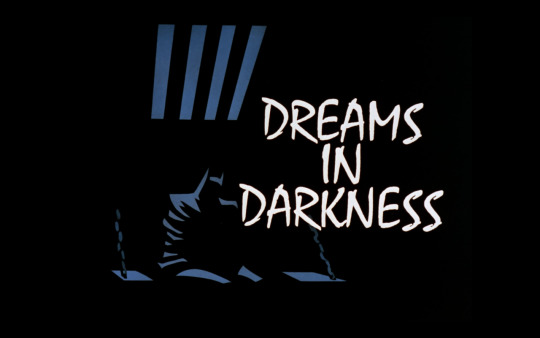
Episode: 28 Robin: Yes (Hallucination) Writers: Judith Reeves-Stevens and Garfield Reeves-Stevens Director: Frank Paur Animator: Studio Junio Airdate: November 3, 1992 Grade: A
Arkham Asylum sucks, doesn’t it. BTAS makes it pretty unclear whether criminals escape or get released most of the time (legally or illegally). But sometimes we are given an x-ray of the inner-workings, and it pushes away any hope that Gotham City has a way of cleaning up its reputation. The last time we had an episode featuring the Scarecrow, we found out that the Scarecrow was supposed to be contained, but a sketchy guard was hiding the fact that he actually was not in his cell. I’m not sure how long that charade could have been kept up, but for the Scarecrow, I doubt that mattered too much, right? Ironically, though, you would think the last thing an escaped patient would want to do would be to wear their infamous costume, stay in the same city, and cause a lot of recognizable trouble in an area as public as a college campus, but we are not exactly dealing with the sane here… This time, only a few episodes later, Scarecrow has somehow gotten out of captivity again. But instead of going all trick-or-treat at sports games, he opts to keep his activities hidden in the shadows below Arkham. There is an old George Carlin routine where he explains how theoretically, living next to a prison ought to be fairly safe. After all, an escaped prisoners are certainly not about to hang around, they’re going to get as far away as possible! Scarecrow may be crazy, but he also seems to be quite intelligent. He was a college professor as some evidence. He probably knows that one of the last places the police would look for him would be under the floor boards. And even here, he hides in the dark, giving orders from the void we so often see cloaking our characters on this show. On top of this, he speaks with a much more menacing voice than before, and at first I thought it was a different voice actor. But no, it is still Henry Polic II. Andrea Romano must have figured out how to actually make the master of fear the least bit intimidating, and it’s about time. Scarecrow for some reason took a while for them to figure out, with him being incredibly goofy in his first appearance, merely spooky in his second, and now incredibly sinister-seeming. Even his mask-design is ever-so-slightly different, although the difference in effect is negligible. What I appreciate more is the difference in his body and posture. Nothing to Fear portrayed him as moving in a very floppy, bouncy fashion, like a Scarecrow might in a little kid’s “Happy Halloween” cartoon special. His body now is angled quite nicely, and he almost stands the way a living corpse would. I’m glad Scarecrow went out on a high note, for the most part (as this is his last major appearance in Batman TAS). Don’t worry, that does not mean that this was his last major appearance in the DCAU!
When the episode starts, we do not know that the Scarecrow will be involved. We get a shot of some Arkham employees talking about a “new patient” who was experiencing some hallucinations. When the cell door is opened and the lights are turned on, we see that it is Batman of all people! When you are not even a minute in, and this is what the episode brings us, it’s like, “Wait. What the hell happened off screen before the show started exactly??” The show immediately plays with our expectations, setting up a mystery and leaving us unsure of whom to trust. We’ve been with Batman for 28 episodes now (plus a pilot), but we also know that he is perhaps not all mentally there, much like so many of his foes. Witnessing him bound in a straight jacket and being treated by doctors is hardly outside the realm of realistic possibilities! But we also know that something screwy is certainly going on, and the way the doctors talk, it’s harder to trust them then it is Batman.
Batman desperately attempts to explain what is going on to the doctors, and asks them if they contacted the people they were supposed to contact, but all he gets as a response is, “He needs more time. See that he’s not disturbed.” GAAAHHHHHH. Pet peeve! I hated as a kid when I would try to explain something, yet no one would take me seriously. It’s infuriating! The doctors act like they care and they are there to help, but ultimately, them listening to what Batman is saying is all an act! They are not hearing the supposedly sane words that they want to hear, so Batman’s garble is meaningless. That has got to be so frustrating, especially given the fact that Batman is trying to save the city from an underground threat!
After this scene, we get some narration done by Batman himself, and this subtly lets us know that, no, we didn’t miss anything, and that it will all be explained by the end of the episode. Batman narrating is also super badass. It would have been real easy to make it cheesy, but Kevin Conroy knows how to deliver. The narration also assures us that Batman is not the crazy one, because his words sound confident (despite showing deep distress) and they make sense. He isn’t talking like a crazy person would talk. We are about to do something that those doctors were not willing to do, and that is hear him out. The narration leads us to a flashback scene (with an awesome music score) where Batman attempts to stop some thugs from messing with the Health Spring Spa’s drinking-water supply, but he ends up being exposed to this red gas that the thugs were going to pump into the pipes. A voice on the thugs’ communication unit also mentions that Batman is “right on schedule”, so we know that this gas was all-too deliberate. This hear helps us piece together the puzzle of why Batman could be locked away. It obviously has to do with the chemicals that he inhaled, but what are the details? And who is behind it? It becomes more obvious as Batman looks up at his screen during a flashback and sees the reflection of the Joker walking toward him. Turning around, he realizes that it is actually Alfred who was approaching. Obviously concerned, he sneaks into a doctor’s office and allows Dr Wu to examine his blood. Apparently the hallucinations are set to get much, much worse, putting him in a state of psychosis. This is where he understand Batman’s intensity earlier in the episode when talking to the Arkham employees. Not only does he need to stop Gotham’s entire water supply from being poisoned by this gas, but he has limited time before he himself goes completely off the deep end. And that brings us to perhaps the greatest thing about this episode.
In Nothing to Fear, we got some fear-hallucinations, triggered by Scarecrow’s toxin. And they were, well, nothing to fear, honestly. We got the image of Bruce’s father’s floating head, telling him that he disgraced the family name for a couple of seconds. It served the plot of the episode, but the weight of it wasn’t exactly felt. We got another one where Bruce’s father turned into a skeleton-like figure, but again, it didn’t do a lot for me. The hallucinations seen in Fear of Victory were a lot better, but they still weren’t the best of the best. Dreams in Darkness, though, this is the Pink Elephants episode. It’s the peyote-in-the-desert episode. It’s the Squidward in Clarinetland episode. The hallucinations that Batman experiences are incredibly intense for a show appropriate for children, the most intense one being the giant pistol that goes off, representing the murder of Bruce’s parents. This is accompanied by bloodcurdling scream from Batman that gives goosebumps. The sequence is incredible well-done, but there are several more that we get to experience. If you are into bizarro sequences in animation, this is the episode where BTAS did a bunch of them, and I would say it is worth checking out just for that. But add in some other great things like a good mystery, the Scarecrow at his best, some awesome atmosphere, etc, and it is extremely worth checking out.
The episode even managed to fool me at one point, despite having seen it before. There is a point where the doctors inject something into Batman to sedate him. I was thinking we were gonna figure out that the stuff being injected was actually more fear-toxin, and that they were working for the Scarecrow. But no, as far as I can tell, they were legitimate doctors, even if their competence wasn’t that high. Hell, they question why Batman would think that Scarecrow might have escaped, when just four episodes ago that very thing happened. Jeez, guys. Even if they were new doctors to the place, you’d think they’d be informed that Scarecrow is a slippery one. How can anyone have confidence that Arkham Asylum is a safe place for criminals to go?
The episode of course ends with Batman facing his fears and defeating Scarecrow. Scarecrow is no match for Batman in a physical fight, and it probably brings him back to the glory days of high school where jocks beat the shit out of the nerds (that’s a joke, I was a huge nerd/geek in high school who stood no fighting chance against anyone). I loved how every time Batman would suffer a hallucination or face a new, scary challenge, he would simply keep on trucking. He would get done going through something absolutely terrifying, then stand up and calmly move forward. It was a situation where Batman knew that he had no choice, and that if he didn’t do this, then it wouldn’t matter anyway. Gotham would be up the creek without a paddle. At least until the military got involved. He even put off his own treatment (which would put him out of commission for a couple days) until after the Scarecrow problem was solved.
Check it out if you haven’t! Of course, my words can only do the show so much justice, so take a look at this episode’s screenshots! Is this an excuse to stop writing? Maybe… I’m just tired of being behind on these blogs… I’m gonna try to bust out a few of them tomorrow. It’ll put a lot less stress on me…
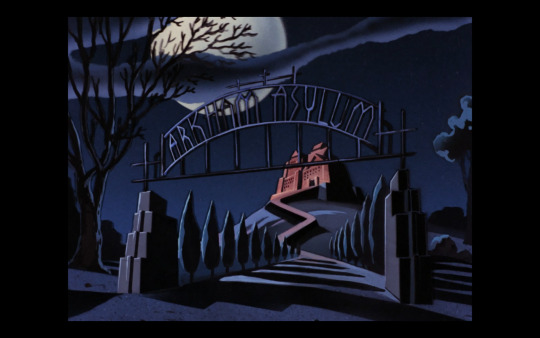
Had to use the Blu Ray footage this episode. But it all looks pretty nice, so enjoy some high def!
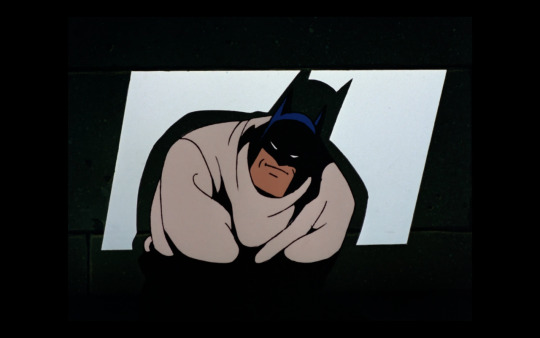
A twist beginning can be just as powerful as a twist ending. We also don’t often see Batman in such a powerless situation. Like Bugs Bunny (but with a completely different approach), he always exudes a sense of control.
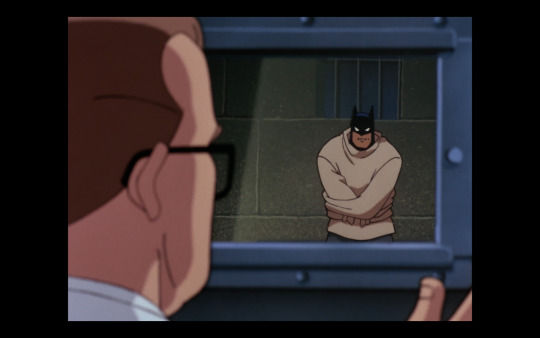
How do animators get this blur effect? When the camera shifts focus?
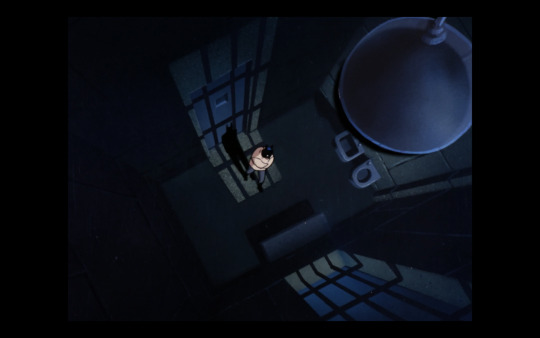
The lighting from the window is angled gorgeously. It’s also a shot that makes you wonder how the hell Batman is ever going to escape (Char gave me this insight).
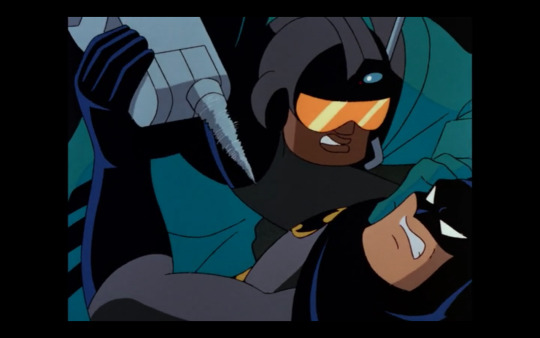
It’s not every family cartoon where you see someone about to be drilled through the chest.
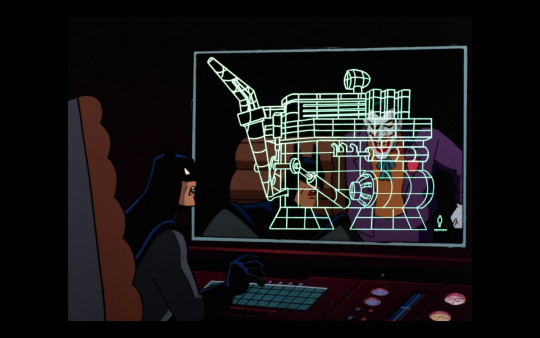
As the Joker suddenly appears as a reflection on the screen, we don’t get an dramatic music or anything. So when we see that it’s actually Alfred, it makes us feel almost as silly as Batman for worrying.
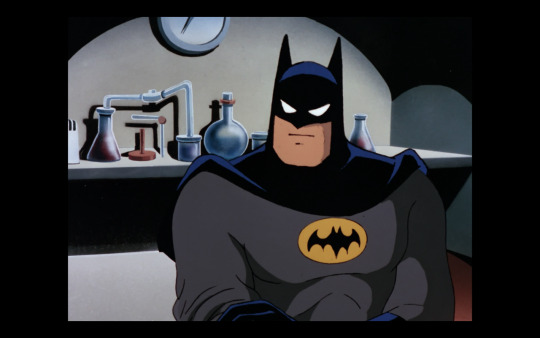
A pretty good shot of Batman’s face, but the rest of his body seems off to me. Also, this is our first time seeing Batman in-costume getting help from a professional like a doctor.


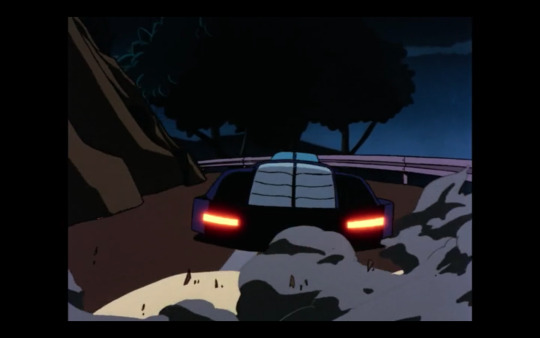
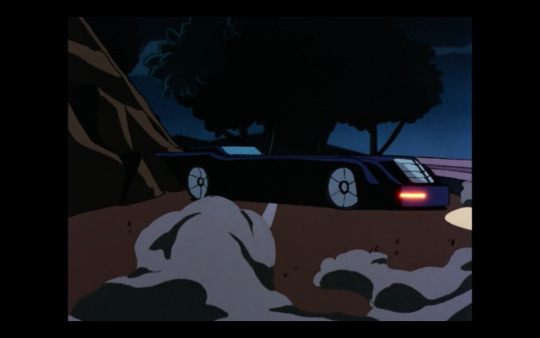
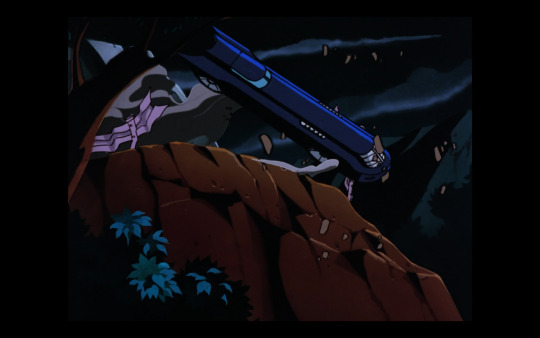

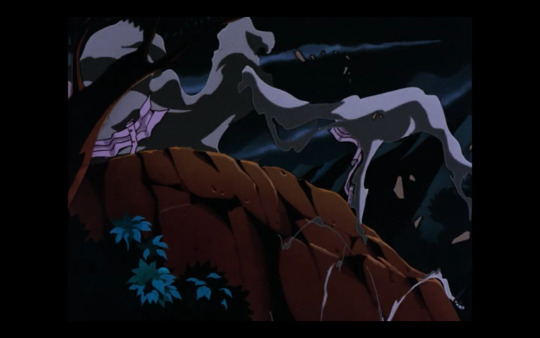
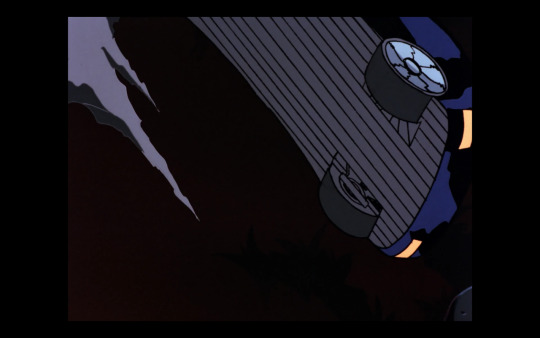
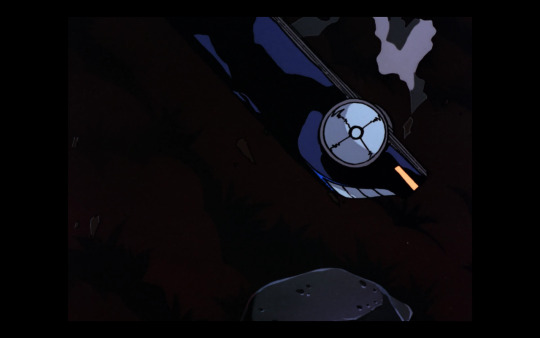
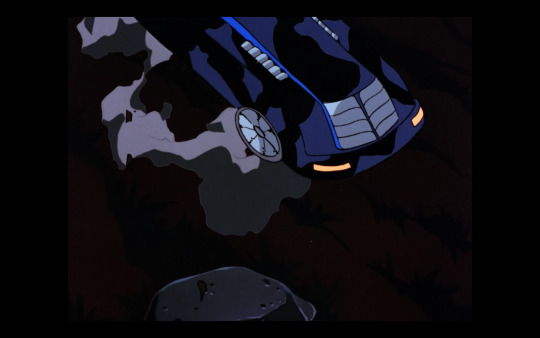
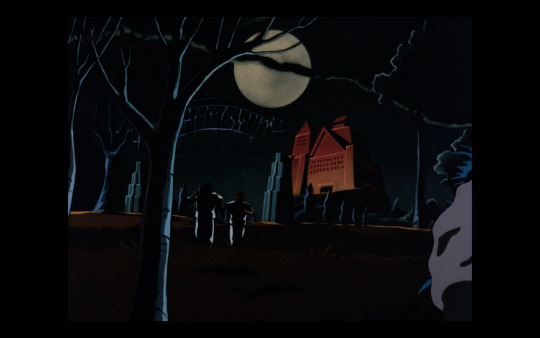
Well animated crash sequence, ending in a shot of the asylum as two doctors sprint out, heading for the crash sight. Great transition.

So as Batman talks to the doctors, I noticed that one of them refers to the Joker as Jack Napier. Is that his actual name in this show? Or is it merely an alias (and one of many?). No spoilers, I wanna find out through the episodes and comics!
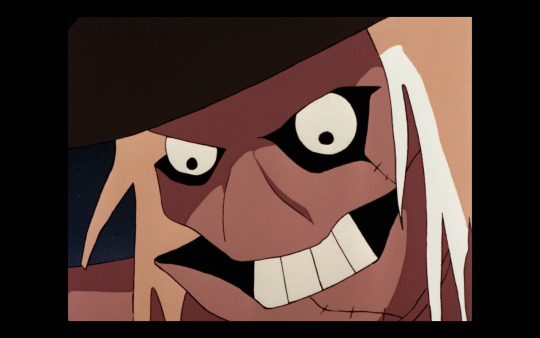
Here is what the Scarecrow is looking like this time. Compare this to his last appearance:

His design is certainly shifting toward the more angular, streamlined look of future DCAU shows.

Is that sweat or a tear, Batman????

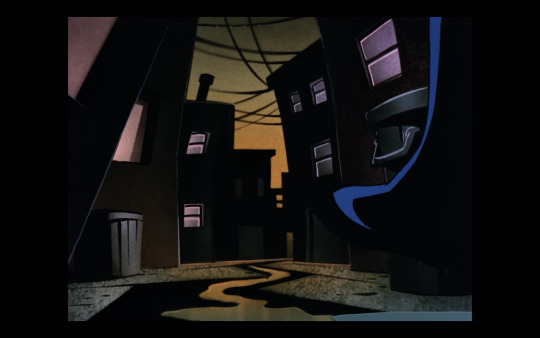
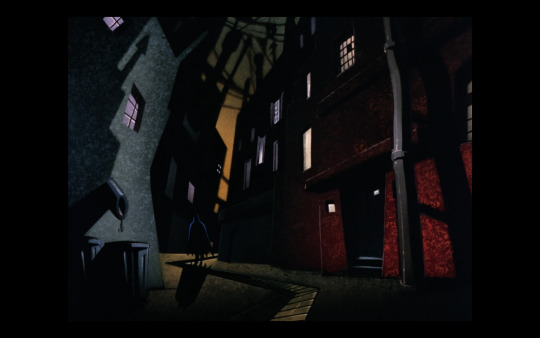
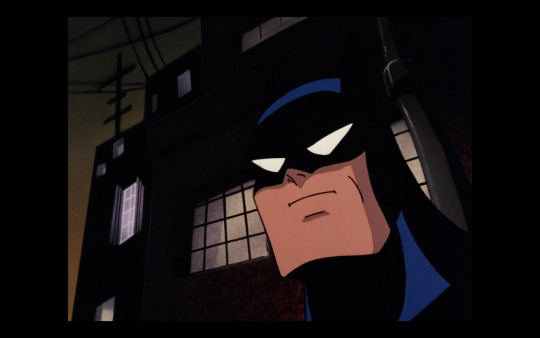
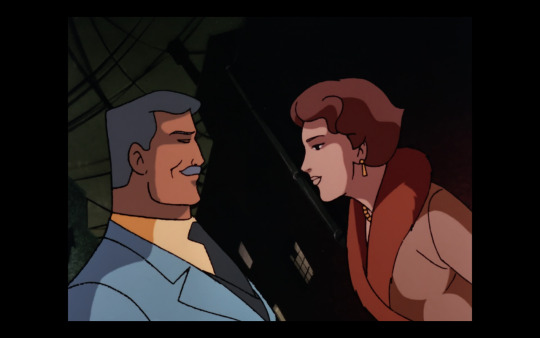

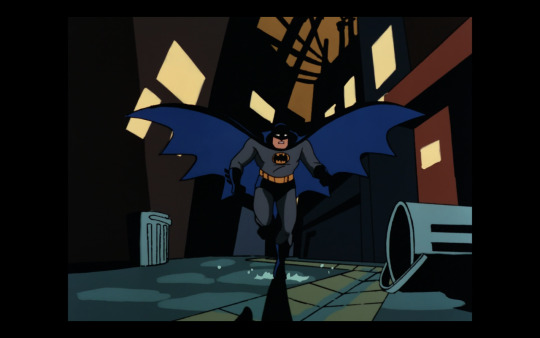
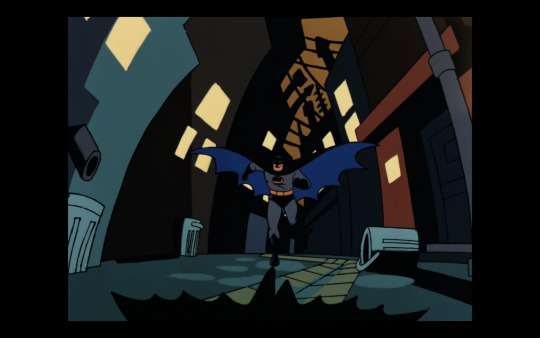
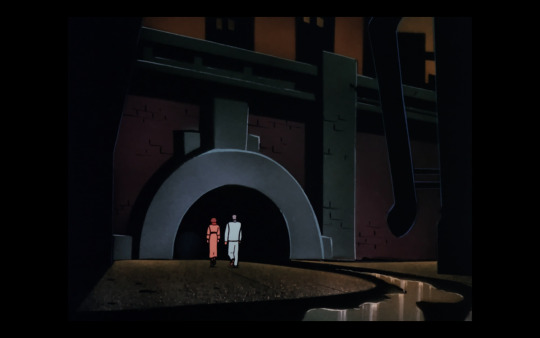
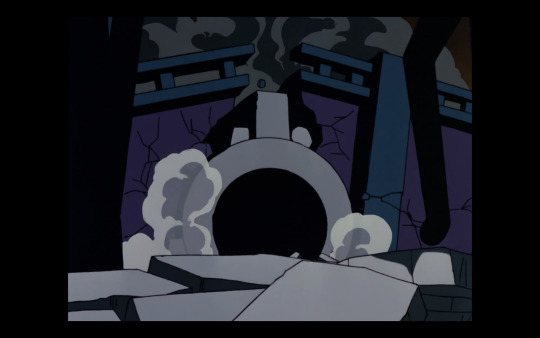
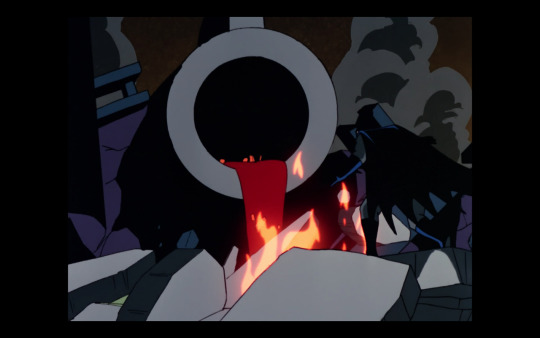
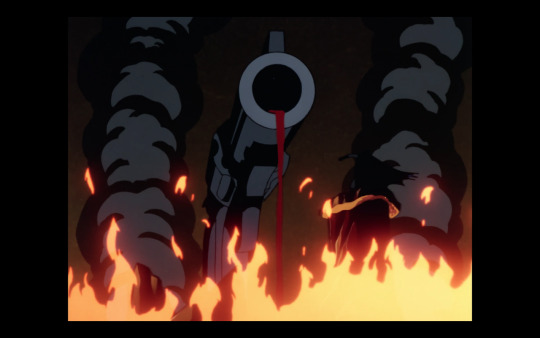
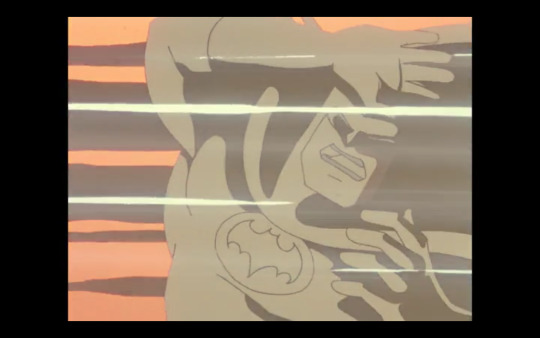
One of the hallucination-sequences that was so powerfully sad and ctreative (Char). Instead of simply leaving the gunshot to our ears, we see the tunnel they enter morph into a giant gun, and blood runs out of it. I don’t want to quite call this personification, but it is a very warped interpretation of what happened last night and it gives us somethin far more interesting than anything offered in Nothing to Fear where it was much more straight forward.
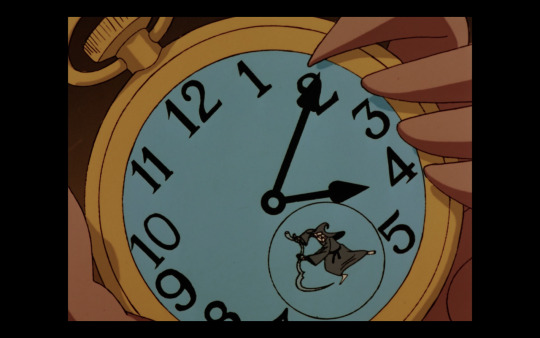
Scarecrow’s clock is very cute.
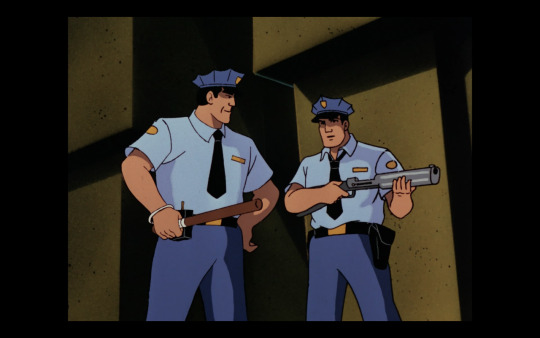
I like how they both look at each other after missing Batman with a traguilizer dart. Like, “Good going, Frank.”
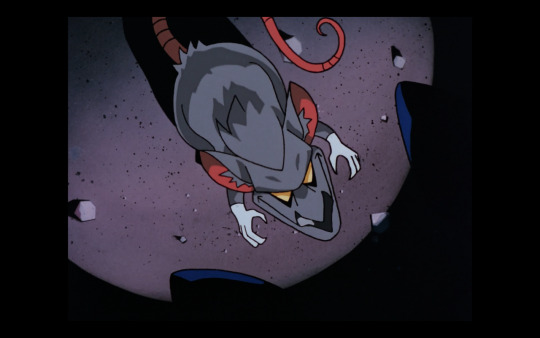
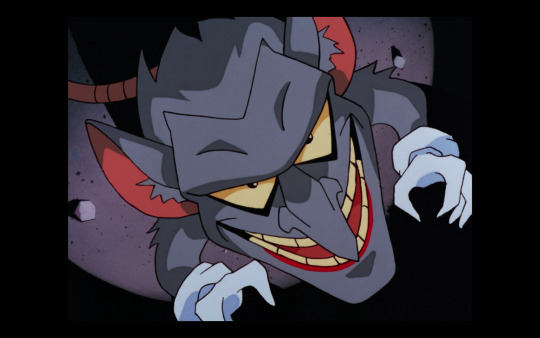
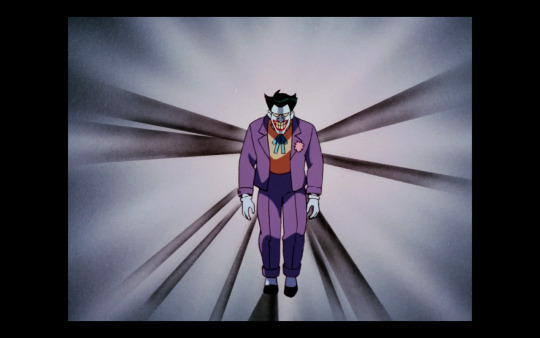

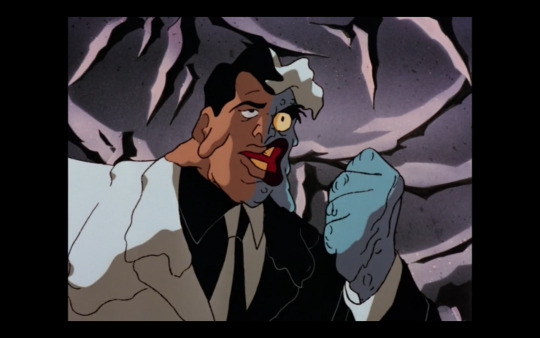
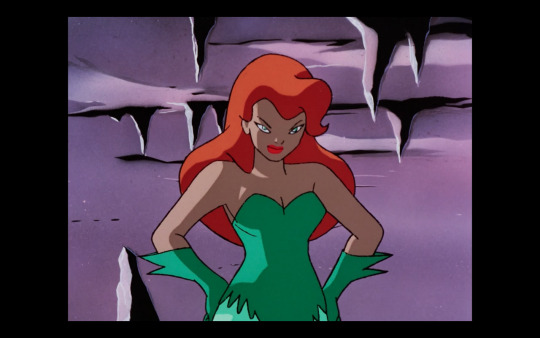

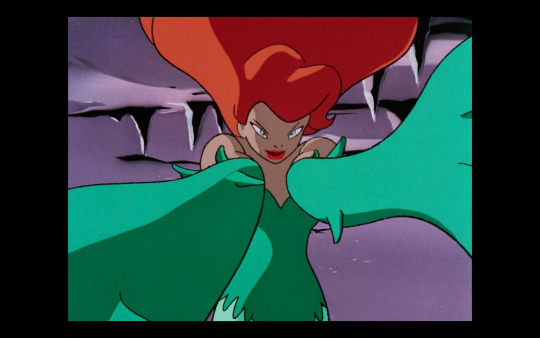


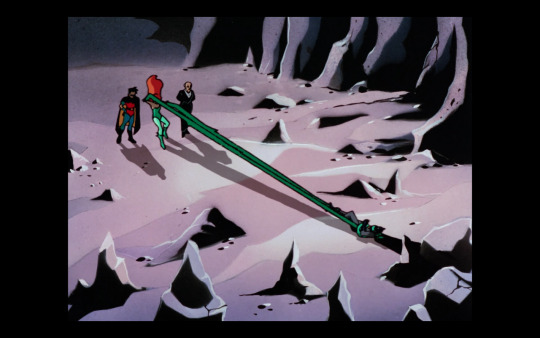

Batman was trapped in a mental hospital where most of his arch nemeses are also being held. That has to keep a guy on edge. No wonder he’s having these particular visions. Robin and Alfred’s voice actors do a great job here sounding like evil versions of their normal selves. It’s all quite unsettling.
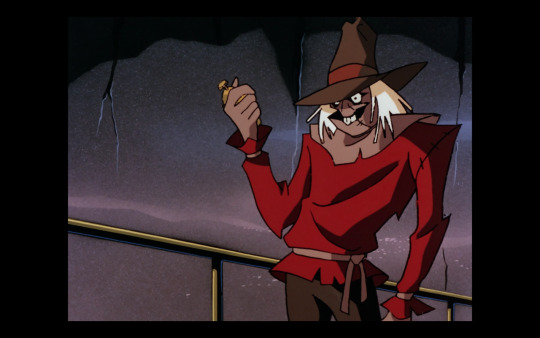
Look how great he looks!!!
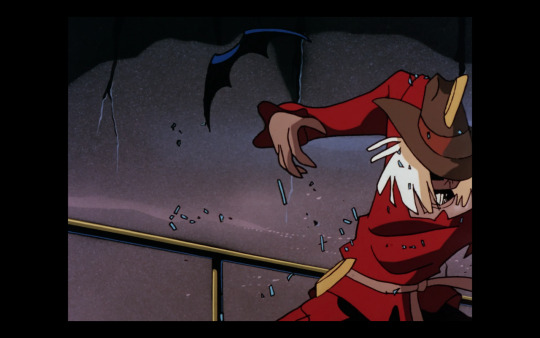
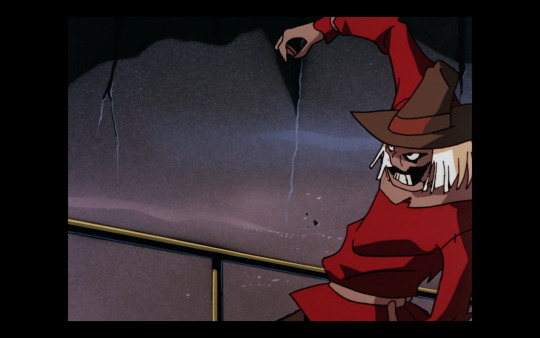
This batarang moment was dope. Look at those two stills. This is Studio Junio, the same ones who animated The Underdwellers.
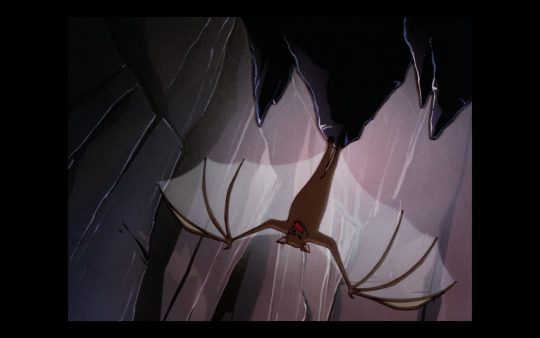
That’s all for this episode!
This show has the ability to make so many viewers feel young again. It’s no demetrite, but it gets the job done... Join us next time!
Char’s grade: A Next time: Eternal Youth
Full episode list here!
#dreams in darkness#dc animated universe#dcau#batman tas#batman the animated series#btas#scarecrow#arkham#arkham asylum
7 notes
·
View notes
Text
RWBY - Volume 6, Chapter 11 Production Analysis
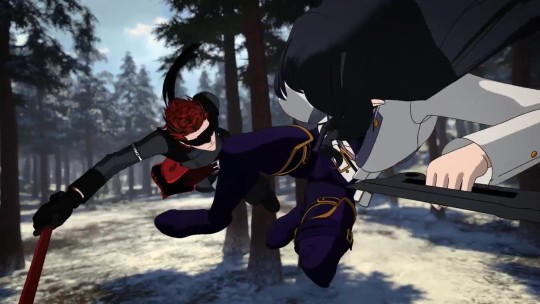
Previous Volume 6 Production Analysis Posts:
Chapters one, two, three, four, five, six, seven, eight, nine & ten
A lot of anticipation for this episode was built up by various members of the CRWBY and for a few big reasons. Since the episode first premiered, a lot of buzz (pun not intended), debates and speculations have gone around across every corner of the internet within the fan base. So let’s try to make as much sense about everything that went down behind-the-scenes.
What is considered very surprising in hindsight is that despite its run time at only 15 minutes, it is the most action-packed episode since the volume premiere. That means that there is a lot to break down regarding who did what and while there has been some confirmation, it’s not all specified from sequence-to-sequence. No doubt such details will be reserved for audio commentaries in the eventual volume 6 blu-ray release, but for this analysis, much of what will be discussed is mostly educated guesswork.
That being said, one thing made clear is the list of storyboard artists and to a lesser extent, which one them were involved with the boards for which scenes. I made an observation last week how the last chapter had six artists assigned to handle the boards which is the most this volume has had since chapter 2 (though not the most in the series, that honor goes to chapters 1 & 2 of volume 5). In this episode, only Rachel Doda, Kevin Harger, and Cassidy Stone were credited. It is still unclear as to what the rhyme and reason is behind the amount of storyboard artists varying from episode to episode the way they do, though scheduling is a possibility. As for who was responsible for which scenes, it’s not totally certain which segments were done by Cassidy Stone, but thanks to the 11th episode of Crwby - Behind the Episode, it is confirmed that Rachel Doda was greatly involved with the first half while Kevin Harger largely did the latter half. There was one major thing that was the focus of how the visual direction flowed in the first fight, that being how Ruby and the others would each face Cordovin’s giant mech.
Scale was the main idea between eight characters and one giant machine. The camera needed to get the feel of how characters would dodge and defend themselves against every close-range and projectile attack and get closer towards whatever part of the mech they could get to. That represents the bulk of what needed to be considered between the director Kerry Shawcross and Rachel Doda. There was also a conscious attempt to keep things consistent in regards to which character was where on the part of the lead camera & layout artist, Kate Warner. For those unaware, camera layout artists are the ones that take the storyboards and animatics that establish the shot composition and timing of a scene and translate that into how the 3-D character and environment models will be placed through the “camera”, that being the way the viewer will see the scene. As mentioned before in one of the posts about RWBY’s cinematography, this team was established during volume 3′s production and due to sharing a few of the same members as in the storyboard department, communication between the two teams and the director would naturally be constant. For dialogue scenes, what matters between storyboards and camera layout is capturing the right mood and expression while focusing the shot on a character based on what a character is speaking about or interpreting as they listen. In action scenes, it’s about capturing the scenario of the conflict between who is fighting who, the size of the characters, the amount of characters fighting at once, etc..
In the production analysis for chapters 2 and 5 of this volume, I broke down observations of what could be the techniques Rachel Doda applies based on previous scenes she did storyboards for. Techniques such as camera rotation, having an object be placed in front the camera for blocking, having a character from the background be revealed to be in focus and long shots of characters in opposing positions are possibly Rachel Doda’s calling cards and while not a lot of them are seen in this fight due to it being different from most other ones, there is one other possible trick she applies in her boards. In instances such as the Weiss character short and Yang vs the bandits, both of which she did the boards for, they both applied a shot or two of characters that are about to perform an action in brief slow motion. This observation, like many unconfirmed things about these analyses, are of course speculative. But if this were the case, then it wouldn’t be a stretch to say the same technique was a applied in a much bigger way during the Cordovin mech fight, namely when the party split in three ways and when Ruby dodged and rode along each of missiles. It’s not quite like the flair in a missile circus as seen from Japanese animators such as the creator of the technique, animator Ichiro Itano and those inspired by the creator such as Shingo Fujii, Nozomu Abe, Seijoon Kim, and Yasushi Muraki, but I will certainly take what RWBY had to offer. Now if only we knew who animated that sequence.
youtube
Though to backtrack, there is some confirmation who at least took part in animating the fight. Among the confirmed animators were Collin McAtee, Nicole LaCroix, and Vince Cappelluti. Vince seems to have specifically animated the sequence with Weiss helping provide split-second cover, not including effects while Nicole and Collin contributed to helping animated Cordovin’s mech such as in the opening cuts, among other things. Timing the mech to even move and function as convincingly slow as they did while also having other characters move in a nimble manner must have been an interesting challenge on their part. Some other noteworthy bits of animation were the way Qrow and Ruby each descended to cut down the mech. Similar to the sequence when Qrow and Ruby took down the Sphinx Grimm, there’s a lot of character between how each of them lunge down with their scythe weapons. One displays more technique due to experience and comes off more acrobatic while the other is more wild and eccentric which aligns a bit with the behind Ruby’s character design as Monty Oum stated working on with concept artist, Ein Lee. Another instance of good character animation in the midst of all the action was the small moment when Qrow and Ren destroyed the shield generator. Qrow would naturally spin his weapon before firing whereas Ren is more comfortable following his lead and time when he fires his weapon at the same time.
One glaring misstep though would be towards the end of the first half of the episode where Cordovin catches the missile Maria fired. Putting aside whether the idea of a missile not exploding on contact the way it did would be able to suspend the viewer’s disbelief, the issue is that it’s timed too abruptly. Up until that point, the mech’s movements have been animated in a consistently sluggish manner. So to have the hand catch the missile instantaneously felt very off though a possible solution in hindsight may not have required changing the animation. What could have helped alleviate the confusion was adjusting the camera in a more three-quarter view behind the missile and having it slowly zoom out as it gets closer to the mech so that when it’s caught, it would be a bit easier to see how it got caught in the viewers mind.
Speaking of camera movement, a much more positive sequence was Jaune dashing over to soften the impact of being swatted by the mech. As stated by Rachel Doda in CRWBY - Behind the Episode, this was a deliberate choice on Kerry’s part to get the sense of power behind the swing. The sequence also helped provide an example of how much camera positioning can make a difference in an action sequence. One complaint some fans expressed about the Battle of Haven episodes in volume 5 was the usage of reaction shots as if they utterly disrupted the flow of fights. However, as certain action scenes in volume 6 show, reaction shots are not inherently a bad thing and the effectiveness of them can depend on the right angle being used. In the shot where Jaune runs covers for Nora, the latter stays in the same position and doesn’t move. If the camera say, remained at a static eye level as we see Jaune run towards Nora, a given viewer might complain that Nora isn’t running away. However, since the camera only tracks to Nora briefly, then back to the mech and then proceeds to follow Jaune til he and Nora get hit, one’s belief is more suspended.
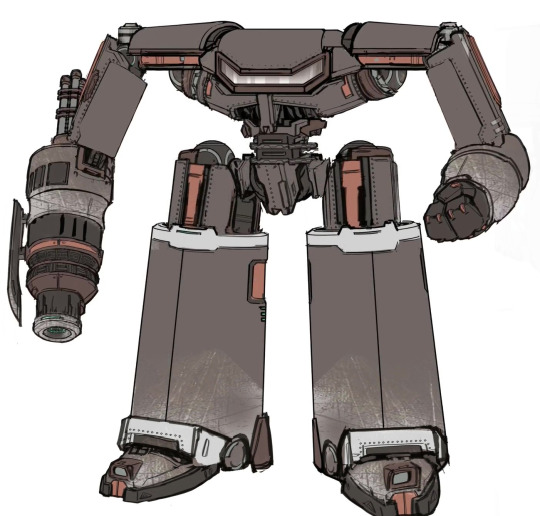
One aspect that definitely served a big part of what makes the first half of the episode what it is are the effects. We got a taste of this in the previous episode with Cordovin firing lightning dust, but now we get an array of various element-oriented dust effects, both in 3-D and 2-D. between the dust chargers, they each were given nuanced approaches in terms of how they built-up energy and how they were released. The ice dust blast emits energy in a more subdued manner before it interestingly releases cold, poofy-looking air and then unleashes a brief beam that recoils the cannon. When Weiss blocks the attack, the earth wall is in of itself pretty simplistic by just having the effect stretch. But the real charm is the 2-D effects of the smoke around the wall and most especially, the impact of the ice dust itself and how it forms from our direct point-of-view. By the following shot, we see the same impact from behind the characters which creates a combination of white flashes and dimmed lighting that nearly creates silhouettes. Moving on to when the earth dust is fired, small rocks appear and form and since they swirl in mass numbers, the cannon shakes around a bit. Once the dust is launched, rocks and boulders in larger chunks burst out. What helps sell the burst itself is how the light that was behind the rocks shoots out along with them to make the blast seem more fast and powerful. The smoke emitted upon impact and the white flashes from each cannon fire also help make the stalagmites being immediately formed seem more dangerous. Finally, there’s the wind dust blast which has the air swirl around before firing a burst with a couple of flashes and in the next shot, the blast resembles that of a beam accompanied with rings spreading out then dissolving.
Of course, there were more visual effects going on besides the varied dust cannon fire, one of which being the hard-light dust shield. This is apparently the official name of the type of dust seen in the form of shields and barriers as seen in Amnity Colosseum and the shape of Velvet’s weapons through her camera. This was not even the first time this type of dust was used since the CRWBY migrated to using Maya and 3DS Max as their main animation and modeling softwares, as it was technically used to power the train engine in chapter 10 of volume 4. Right now there’s not much to add other than that it dissipates in a manner similar to how each of the weapons appear. Also, since this was part of the scene, it’s pleasing to see how since this volume, the smoke from Nora’s grenades are not only officially given a cel-shaded pink color but that as they fired with enough distance, the trails start to wobble for lack of a better way of putting it. Other visual effects that have been seen and utilized before such as the waves on the bottom of the cliff side and the ice from Weiss’s dust usage have also been a part of the presentation, but probably the best moment outside of the dust cannon was the giant splash from Cordovin’s missiles. Being 2-D animated likely by Myke Chapman, this must have been tedious to animated frame-by-frame and yet the size and timing was effective at making the impact feel as powerful as it did. The most immediate comparison was to a sequence in episode 23 of One Piece animated by Hideaki Maniwa, whose tendency to liberally have effects be on 1s the way he did made his work a treat to watch in the first couple-hundred episodes of the series.
That was a lot to cover regarding the main party fighting against Cordovin and yet that was only the first-half of the episode. There is still the latter half that focuses on Blake and Yang each having their go against Adam Taurus and indeed is their a lot to unpack. As stated earlier, three storyboard artists were tasked with this episode, one of which being Rachel Doda who handled the former fight. Here, Kevin Harger takes over a great portion and this was actually somewhat confirmed since over a week the episode premiered. Back in episode 9 of season 2 CRWBY - Behind the Episode, insight was given about the motion capture process and in it, footage was accidentally shown of the storyboards for this episode that ended up being leaked on certain corners of the internet. This was of course a blunder and currently the boards have been blurred out ever since. But since the episode proper has become publicly available, now is a apt time to talk about them. The drawings within boards match that of previous storyboards confirmed to have been done by Kevin such as in the Yang character short, the Gods of Light and Darkness confronting each other, Oscar vs Leo and Ozpin vs Hazel, as well as some of his drawings outside of RWBY in general.
youtube
With all of that confirmation in mind, this is a good opportunity to briefly study on Kevin’s techniques with doing storyboards. Of course, this is all observation and storyboard artists tend to work closely with Kerry to go over what is the best way to depict action sequences, so take what will be said with a grain of salt. Although it’s not much, there are two traits to assess from Kevin Harger’s storyboards. First is that scenes he’s involved in tend to display a shot where two characters briefly stare at one another or at least one stares at the other in a brief standoff before the fight proceeds. This can be seen in some of the previously mentioned examples. Second, any character that is seen as having the advantage will be framed in a shot or two as being above the other in height. This will naturally apply to taller characters like Hazel and the Ursa Grimm but is not limited to them as Ozpin when he took possession of Oscar’s body is framed similarly in one shot. The third and final observation is that in a given sequence, one character may be seen dodging and maneuvering either around or somewhat away from his/her opponent as seen with Yang and Ozpin.
The reason any of this matters is because for fight scenes, the storyboards help determine the choreography and shot composition just as much as the animation. In fact, depending on how much the animators want to stick closely with them, the boards can determine the choreography even more so. This is something that fan-favorite animator of RWBY, Kim Newman. expressed when talking about animating the Yang character short at the Just the Fights Panel at RTX Austin 2018. stating how important storyboards are and they have helped saved her time and stress. Going back to the Blake vs Adam fight, the observations made earlier about Kevin’s previous storyboards can be seen here such as Adam being framed as bigger than Blake and the two characters in a brief standoff. Also, every action and reaction the characters communicate through their movements and the emotions in Kevin’s boards can serve as great fuel for the team of animators assigned to the fight once they see the animatic. Another possible way of getting the animators psyched up for the fight in this episode and perhaps even Kevin when having done the storyboards would be knowing that Blake intends to dual-wield. As unusual of a source this is, on March 15th, 2018, Kerry Shawcross confirmed to a fan named Casualdoom12 via the live chat of of a stream of RWBY volume 5 in regards to whether or not Blake would dual wield in the future by simply saying, “yeah.” Many fans have accused Kerry and Miles of forgetting how certain characters fight until they suddenly remember to. But sources have strongly argued otherwise, such as with Qrow and the scythe mode of his weapon, Harbinger according to the volume 3 blu-ray directors audio commentary track with his fight against Winter:
Miles: “It was your idea by the way to have the transformation start and stop as the ultimate cock tease.”
<Kerry laughing>
Miles: “To this day, I’m still seeing comments, “WHEN ARE WE GONNA SEE THE SCYTHE?!” It was, I loved it. It was great.”
Kerry: “We just kinda wanted to mess with people.”
Miles: “Y-you and me?”
Kerry: “Nooo, naaaah.”
And in the volume 4 blu-ray directors commentary track with his fight against Tyrian:
Kerry: “So uh, a lot of people wondered why he never went into scythe mode during the fight. We actually talked about that for a really, really good amount. And really what it comes down to is it’s just not, it doesn’t seem like it would be fast enough.”
Miles: “Yeah, it’s not gonna do stuff to fight against somebody like Tyrian.”
Kerry: “No, because Tyrian has essentially got like 3-5 points of contact depending on if he’s using his feet or not. And to just try and block them with that giant scythe just didn’t seem like a good idea. So that was why because I know people really want to see him in scythe mode, but we just felt it would feel forced and not make a lot of sense for him.”
Then there was the matter of Velvet deciding to use a hard-light dust version of Penny’s weapon, again in the volume 3 director’s audio commentary:
Miles: “What was the um... what was it like-oh, I think you were the one that had the idea to end with Penny’s swords too.”
Kerry: “Yeah, so we knew like, “okay, we’re gonna have her cycle through a bunch of characters’ weapons. Ya know, we named off the main four, we talked about some other ones and then it came down to the last one and for me, immediately it was like, “it has to be Penny.” Like, there’s no other way to do this.”
Gray: “There was the briefest debate about whether or not Penny herself should be able to show up because technically the weapons are a part of her and vice-versa.”
Kerry: “Yeah.”
Gray: “And it would’ve been a different moment.”
And then in episode 13 of season 1 of RWBY Rewind, Kerry and Miles answered the matter of how aura breaking or flickering works and cited the Ghira vs the Albain twins fight, stating that he did not forget to depict Ghira having his aura already depleted so much as he was more okay with the idea of that instance happening off-screens than viewers would’ve been. Kerry is not absent-minded. He spends a lot of time with Miles contemplating in the writing process over whether a character should a particular thing in a fight, depending on the fight itself and communicates that with the storyboard artists, animators, VFX team and whoever else. Having Blake dual wield when fighting against Adam was no exception as this was meant to be defining point in her character story.
So with the matter of the storyboard artist’s and Kerry’s input into this fight established, who animated it? The team responsible for this latter half are the assistant lead animator, Melanie Stern, Matt Drury, John Yang, Megan Pellino and Joe Vick. These same names have popped up before in the fights for chapters 5 and 7. John had also done much of the fight in chapter 10 and he also handled the first segment with Blake and Adam in the forest as I mentioned previously. Seeing the full version, his portion likely extends right up until Blake and Adam enter the ravine. After that though is where identifying who did what gets a bit tricky. My best assumption would be that what follows up at least up until Blake’s Gambol Shroud is broken is all Melanie Stern. A bit of her camera work and timing feels familiar based on previous fights she worked on. Though if she really did this segment, then this is probably one of the most fast-paced sequences she’s ever animated in a fight scene. Instances such as Blake twirling a bit so that she faces Adam’s gun before using her semblance or parrying Adam’s sword in such a way that it slides across her katana and into the sheath portion of her cleaver are so quick and seamless that one would easily miss those moments if he/she blinked.
Once Blake is down and the katana portion of her Gambol Shroud is broken, things die down briefly as we get some facial expressions and character acting. In the shot with Blake, her expressions easily read that she is aware of and understood how and why Adam got his scar and that a part of her felt sorry for him. In contrast from Blake’s more nuanced expressions though, Adam’s are more explicit and seeing him unmasked definitely brings great synergy between what he emotes and Garret Hunter’s vocal performance. Given that Blake’s expression is subtly different between the end of this cut and the start of the next one, most of this segment and Yang’s dynamic entry with having her bike crash into Adam was all animated by Megan Pellino, the latter of which was definitely confirmed by Melanie. This is actually the first time we learn which part of a fight Megan has done and although it’s not much, the moment itself was bound to satisfy viewers.
Now comes the Yang vs Adam portion and there’s a couple of big things to break down from a production standpoint first. Referring back to episode 9 of CRWBY - Behind the Episode season 2, there was more being implied about what goes on in this fight than just the storyboards. The motion capture actually previewed the standoff portion of the fight before Adam lunges at Yang. It seems that in the session, Melanie Stern was doing mo-cap for Blake, either Nicole LaCroix or Nicole “Nyx” Morciniec did mo-cap for Yang and Matt Drury did mo-cap for Adam. The last one is particularly noteworthy and yet unsurprising since Matt has gone on record to liking Adam’s character and having done mo-cap for him before. On top of that, Matt has been absent in the staff credits since after chapter 7 which is not the first time an animator has been uncredited for whole episodes in a row due to going from being involved in one big scene to being involved in another one later in the volume. This same thing happened with Dillon Gu during volume 3 who went from animating the double rounds fight in chapter 4 to the students vs the Nevermore and Ironwood vs the Alpha Beowulf in chapter 10.
One could argue that he had to dedicate time working on Gen:Lock but given the timing, Matt probably anticipated this moment too much to not want to dedicate as much time for this sequence. Having said that, here’s where where the other piece of behind-the-scenes information comes in. Back in 2016, former co-lead animator Shane Newville publicly posted an open letter about various things regarding RWBY’s production, including during volume 3. I’ll spare the details and the source since his perspective and frustration on things regarding Monty Oum’s vision, while understandable given how dear Monty was to him, is also distasteful when taking insight about volume 3′s production from Kerry, Miles, Gray Haddock, then lead producer, Koen Wooten, and every other staff member’s perspective into account. Rather, I’ll refer to a small quote from his letter about a fight Monty Oum was working on prior to his passing:
“Next up was another scene that I had been looking forward to for a very long time. Blake was meant to fight Adam, and then Yang was suppose to come in and take over the fight, protecting Blake from death. Once I was done with Yang vs Mercury, I asked about this long-anticipated, ultra-badass scene.
But guess what-- they didn’t even write it in the script because they didn’t look at what Monty created for the scene before they began! It was all available to them before Monty passed away and after he was gone I made sure all of those scenes were available to them-- that they had them in their hands. It was even more of a surprise to me since I had rendered out Monty’s timelines for them, at the producer’s request, before production even started. they didn’t even look at what Monty, the creator of the show, made for this show.
Let me add that the Yang vs Adam fight was looking beyond badass. Monty was using a Linkin Park song as the soundtrack to animate it to. I was told that they would just find some other place for it down the road. But I know that when they eventually make the switch to Maya, everything Monty and I worked so hard to build up will become unusable and therefore thrown into the garbage.”
Tonal choice aside, much of what Shane stated is very likely the case when examining the unfinished footage that suddenly surfaced around the same time as RTX Austin back in August 2018 according to reddit user JauneBlackSmudge. Even the temp music for the sequence is from the Linkin Park song, “Session”. It is unclear whether Shane himself uploaded the footage or someone else anonymously did and it’s currently unconfirmed whether Kerry Shawcross himself had possession of the footage and wanted to reserve it. Regardless, it’s clear that snippets of it were directly referenced and adapted into the Yang vs Adam fight seen in volume 6. Even Shane’s claim about Kerry finding another place for this fight somewhere down the road would support past cases where Kerry has talked about usually pushing ideas out of the script or production of one volume and reserving them for another one. Rarely ever does an idea get scrapped altogether and never use it with a couple of exceptions such as dust-powered cars according to art director, Patrick Rodriguez and the double-rounds fight between Pyrrha, Nora, Sun and Neptune which had to be cut or else there would be too much of a strain on volume 3′s production scheduling.
youtube
But enough of the behind-the-scenes and on to analyzing the fight itself which is nothing short of exhilarating. As stated, the fight matches snippets of the unfinished clip but has been adapted with more nuance depending on the camera angles and gestures. Case in point, Adam in the unfinished clip throws a slicing boomerang-like wave while the official scene has Adam using his sword like a buzz-saw. It’s also worth noting that when Adam is in the air, his form is very similar to that of when he kicked his sword at the Atlessian Knight in the Adam Character short which was a sequence Matt Drury animated. I previously compared that moment to Ken’Ichi Fujisawa’s sequence on episode 385 of Naruto Shippuden in the Adam Character Short Analysis, it was more likely a direct homage to a sequence done by animator Spencer Wan in the Netflix animated series, Castlevania. Once Yang is done blocking, she briefly dashes in with an upper-body boxer stance and starts a series of counterattacks. Like the Cordovin mech fight, the visual effects greatly compliment the motion by having certain strikes and blows be in the form of arcs. One of my favorite moments in this sequence is how the rapid-fire punches against Adam’s sword have duplicates of Yang’s arms to implement a blinding speed to them. This may possibly be due to having a copy of the same model blend in to give off that multi-arm illusion. Animator Harley Dwortz was actually the first in the animation team to use this technique way back in chapters 4 and 7 of volume 2 when Neptune was on Yang’s bike and Ruby was given pulled in by Yang. Next is another moment adapted from the unused Yang vs Adam footage where Adam runs around with afterimages and then sends a wave of energy at her. Though like previously, certain nuances are added like Yang’s close-up reaction shot to Adam’s direction and the same effects used in the last chapter against Blake where black and red accented lighting is utilized around him. Also, it seems like the wave itself was drawn in 2-D by Myke Chapman.
After a quick pause in-between, we get to the next sequence where Yang lunges right back and then dodges Adam’s strike to the side in mid-air and then spins herself to get a stronger kick at him. The mid-air dodge actually resembles a sequence from My Hero Academia and it wouldn’t be a stretch if what Yang did was inspired by that either since Kevin Harger mentioned using Bakugo as inspiration for having Yang maneuver mid-air in his storyboards for the Yang Character Short. At any rate, what happens next is that when Adam swings his sword again, Yang shoots to propel herself back but because of how instantaneous it is, it’s easy for the viewer eyes and brain to not register that in normal speed. Then comes another one of my favorite parts about this fight where Yang runs forward but she’s still sliding back a bit due to not immediately having the momentum. Then comes a few punches and some kicks interestingly similar to when Mercury attacked Pyrrha in their sparring match in volume 2. Finally, Adam knocks Yang back with his sword and I love how there are a couple of bounces on her fall before lying on the ground. I suspect that Joe Vick did this sequence who has not been explicit about which cuts he did in any of the sequences he has been involved in this volume. The reason it might him though is due to comparing the timing of the animation here to that of one of Joe’s demo reels where a martial artist character strikes at a sandbag in various ways. The animation in both the reel and this portion of the fight share the similar timing, especially compared to the previous sequence which feels a tad harsher and faster though the overall kinetic energy is not lost in what is presumed to be Joe’s portion.
Then comes the moment that caps off the action segment of the latter-half of the episode. Again, having Adam unmasked does wonders for his more explicit expressions as his pupils are shrunken and expresses ferocity. This is followed by Blake’s cat ears reacting to the sound of Adam’s weapon and his growl, which have been a key component in the action as shown earlier. Then we get the best effects in the fight where Adam is once again shrouded completely in black along with the entire screen this time, minus the red accents on him glowing. I just love how the more powerful his attacks seem to be the darker the screen gets, whether or not that was intentional on the compositing team’s part. Complimented with more black and red sparks, what follows is the icing of the cake with the blast shaped in such an extremely monstrous form. These are the kind of effects that anime fans within the Sakuga community become very fond over between individual animators and although this case is more likely from the visual effects, that does not make the spectacle any less pleasing to see. Then comes a few shots of Yang withstanding the attack and I would be remiss to not mention the fact that yes, the shot composition matches that of the climax in Disney’s Beauty and the Beast. Given that Blake and Adam and somewhat Yang are inspired by the fairy tale of the same name, it would not be absurd to presume that either Kevin Harger or Kerry Shawcross used such shots as a purposeful homage. In the last several shots, we get more of Adam’s expressions that sell his manipulative nature as well as some nice shot composition in the midst of the standoff. Since Adam is focused on Yang, they are both framed in front of the cliffs while Blake is in front of the waterfall. But when Blake’s reaches to hold Yang’s hand, the latter is framed having crossed from the waterfall to the cliffs behind her, thus marking the end of the episode.
Ooh boy, what an episode to break down! A lot happened in both halves of this episode that required more dissecting than the average analysis, especially the latter part. Hopefully, this proved to be an insightful read. Since neither fight concluded this episode, there is obviously more to anticipate and this time things are being teased by Neath Oum, Monty’s brother and the voice of Ren of all people. Once these bigger things come in supposedly more ways than one int he next episode, there will of course be more to analyze about the production.
#rwby#rwby6#rwby spoilers#rwby analysis#crwby#production analysis#production#analysis#kerry shawcross#kerry#shawcross#matt drury#matt#drury#myke chapman#myke#chapman#kevin harger#kevin#harger#rachel doda#rachel#doda
11 notes
·
View notes